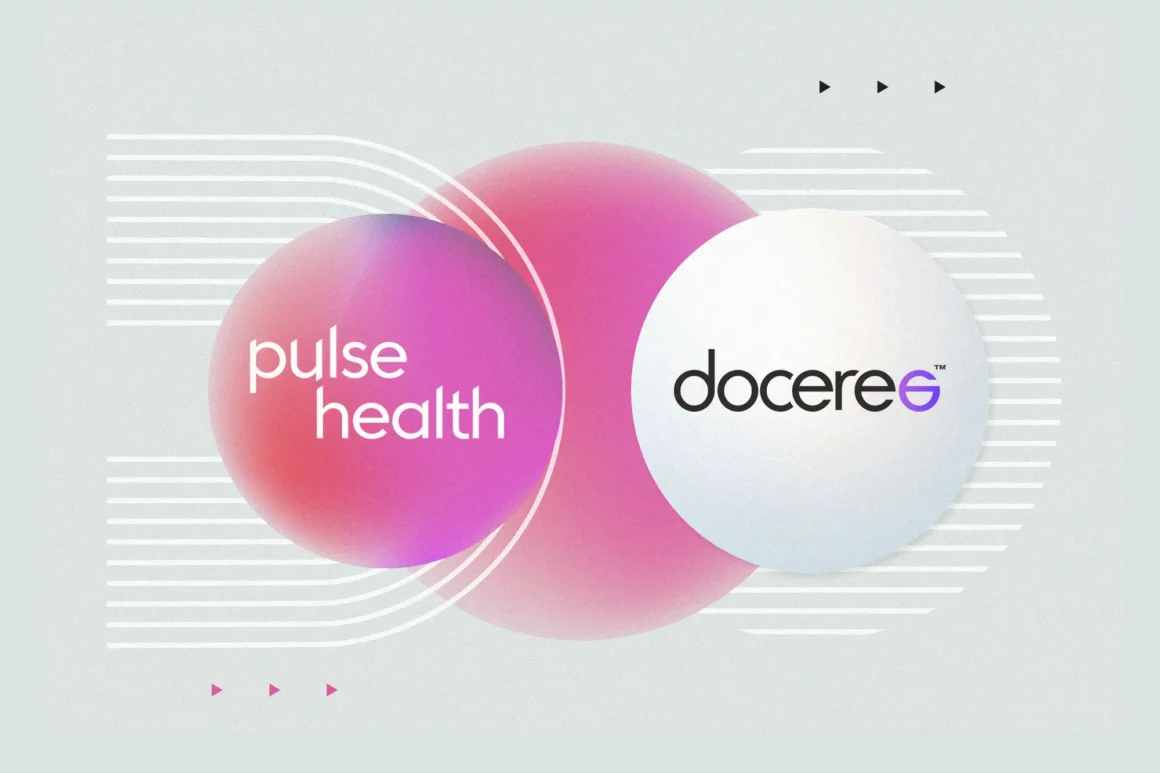Integrating Pulse Health’s engagement platform with Doceree’s programmatic HCP advertising network unlocks powerful capabilities for healthcare marketers. By combining Pulse’s life-sciences-tailored marketing automation with Doceree’s extensive reach to healthcare professionals (HCPs), marketers can coordinate campaigns across channels seamlessly and measure results in one place. This guide explores what Pulse and Doceree offer, how to set up their integration, use cases and benefits, key metrics, and why using them together achieves more than Doceree alone.
Overview of Pulse Health and Doceree
Pulse Health (Pulse Engagement Cloud): Pulse Health provides a cloud-based engagement platform built specifically for life sciences marketing.
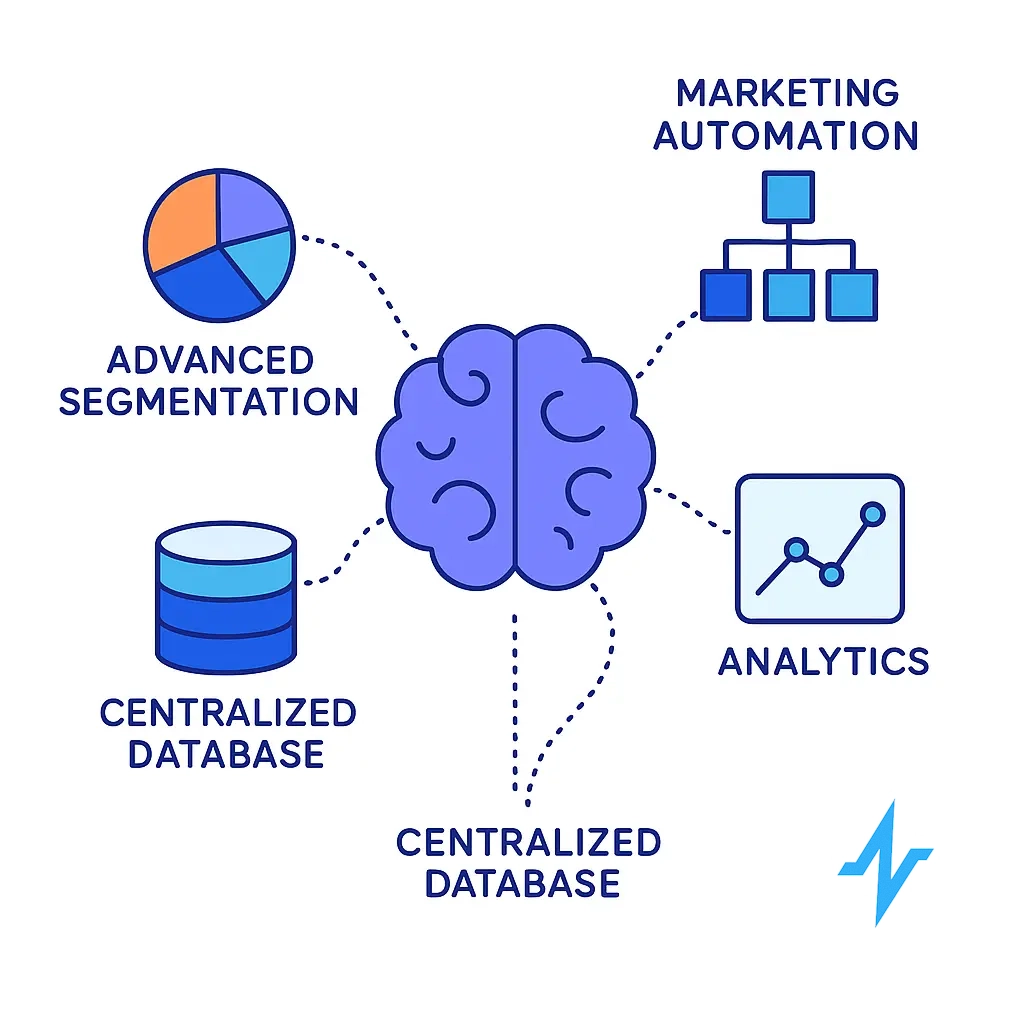
The Pulse Engagement Cloud is an all-in-one solution integrating marketing automation, advanced HCP segmentation, a centralized database, omnichannel campaign management, and analytics.
It’s known as a pharma-native platform that increases marketing outcomes (e.g. boosting prescription lift by up to 20% in one study) and offers pre-built integrations with leading healthcare marketing tools like Veeva, Medscape, Doceree, and more.
Essentially, Pulse acts as the “central brain” for orchestrating and analyzing HCP engagements across channels.
Doceree: Doceree is the world’s first global network of physician-only platforms for programmatic messaging.
In practice, Doceree enables pharmaceutical and life sciences brands to deliver targeted digital “nudges” (ads and messages) to HCPs within their professional workflows – for example, in electronic health record (EHR) systems, medical websites, and other point-of-care or endemic platforms.
Doceree’s patented technology ensures precise, privacy-compliant physician identification and targeting without third-party cookies.

The platform encompasses a demand-side ad platform and data management tools that allow marketers to reach over 2 million verified HCPs globally with tailored, contextually relevant ads at critical moments of care. It provides real-time analytics and reporting down to the physician level, so marketers can monitor campaign impact (such as engagement and prescribing outcomes) instantly.
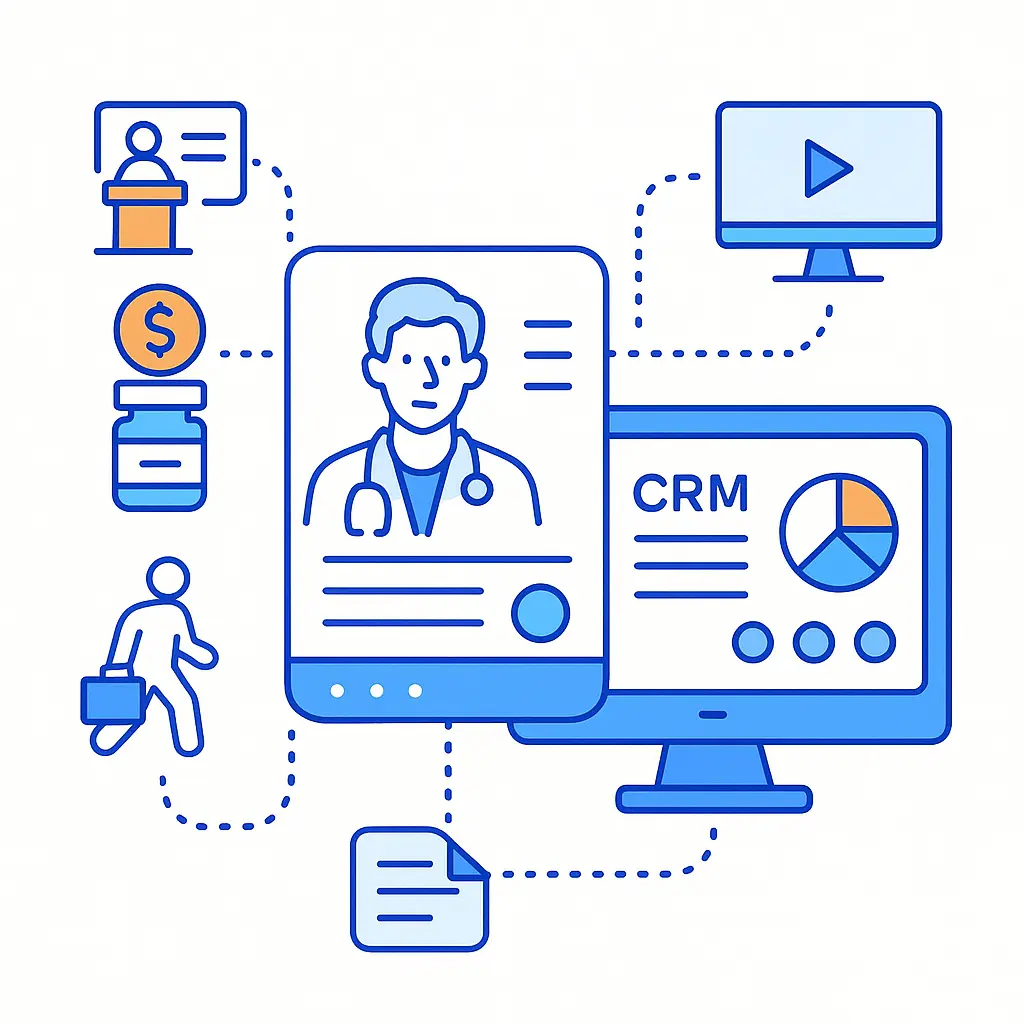
The Bottom Line: Pulse is a comprehensive HCP engagement and marketing automation platform, and Doceree is a programmatic HCP advertising network. Integrating the two allows healthcare marketers to plan and execute an omnichannel strategy – using Pulse to coordinate and analyze, and Doceree to extend reach via targeted digital ads to HCPs – all in a unified workflow.
Why Integrate Pulse with Doceree?
Integrating Pulse with Doceree brings together the strengths of both platforms, solving common challenges for healthcare marketers:
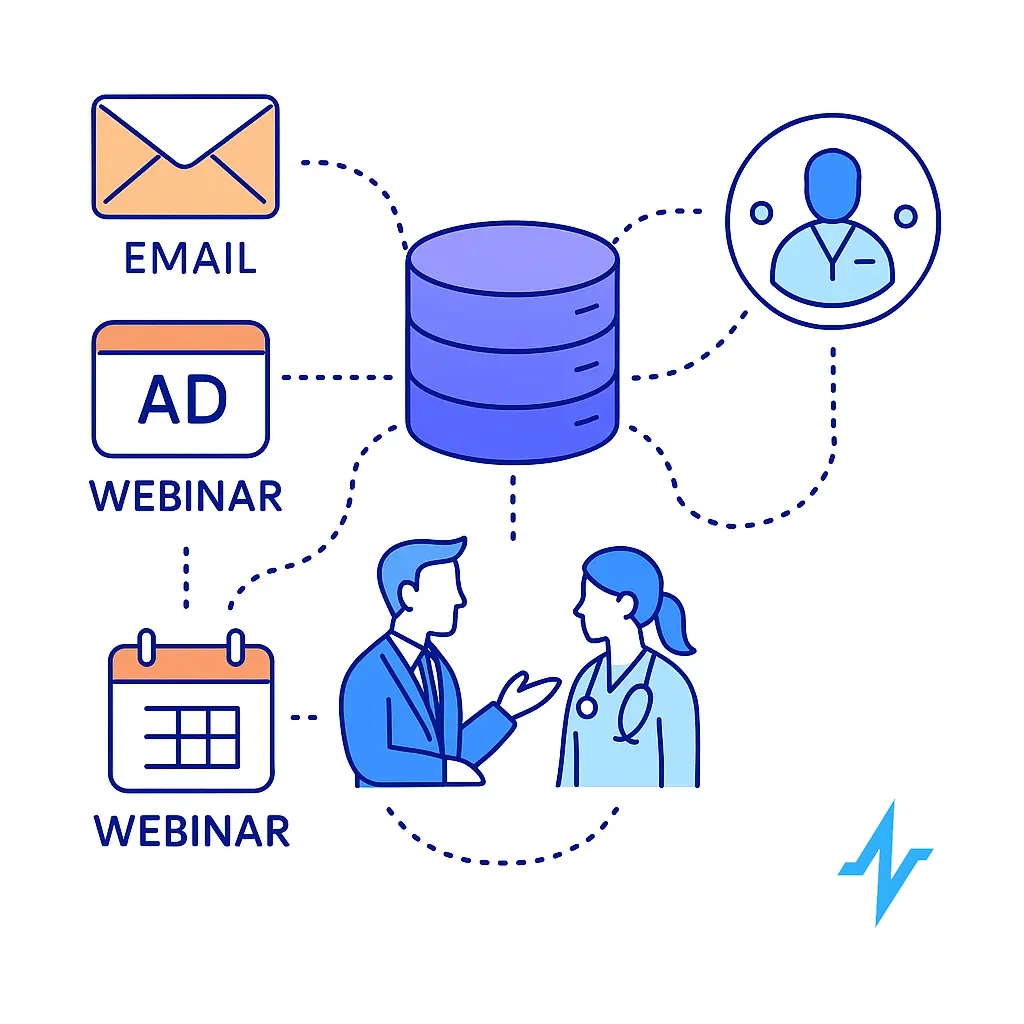
Single Source of Truth: With Pulse as the hub, all your HCP engagement data lives in one place – eliminating the need to jump between multiple systems or wait on separate reports.
Instead of siloed email metrics in one tool and ad metrics in another, Pulse + Doceree integration centralizes everything.
Marketers gain a 360° view of each HCP’s interactions across channels (email, reps, Doceree ads, etc.) on one profile. This unified data means you can see, for example, that Dr. Smith received an email, saw a Doceree banner ad, and attended a webinar – all in one timeline.
Cohesive Omnichannel Strategy: Bringing Doceree’s channel into Pulse’s ecosystem enables truly cohesive omnichannel campaigns.
Pulse’s integrations with trusted partners mean you can “bring everyone under the same tent” and execute a coordinated marketing strategy through one partner (Pulse).
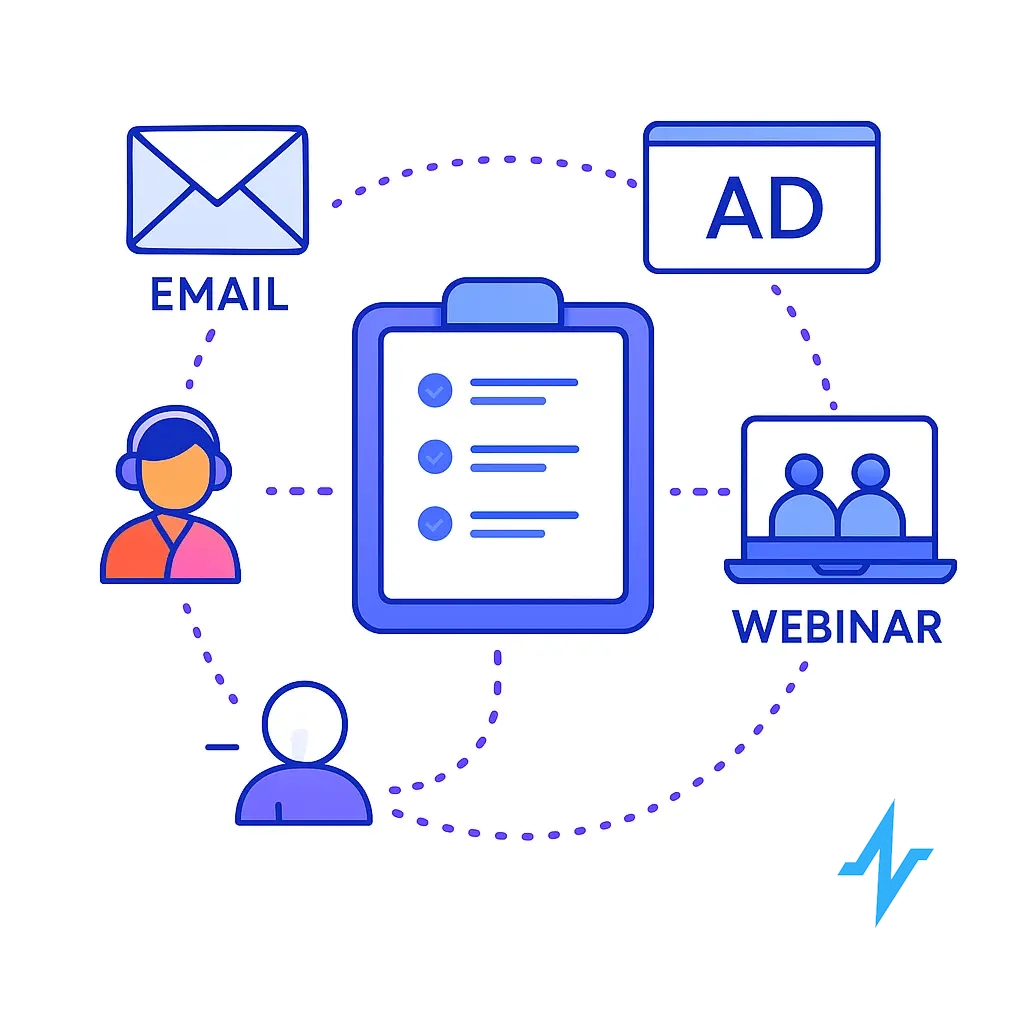
For instance, you might use Pulse to automate an email series to a target list of cardiologists while simultaneously leveraging Doceree (via the integration) to serve those same HCPs contextually relevant ads on medical journal sites. The messaging can be synchronized and consistent, reinforcing each other across channels.
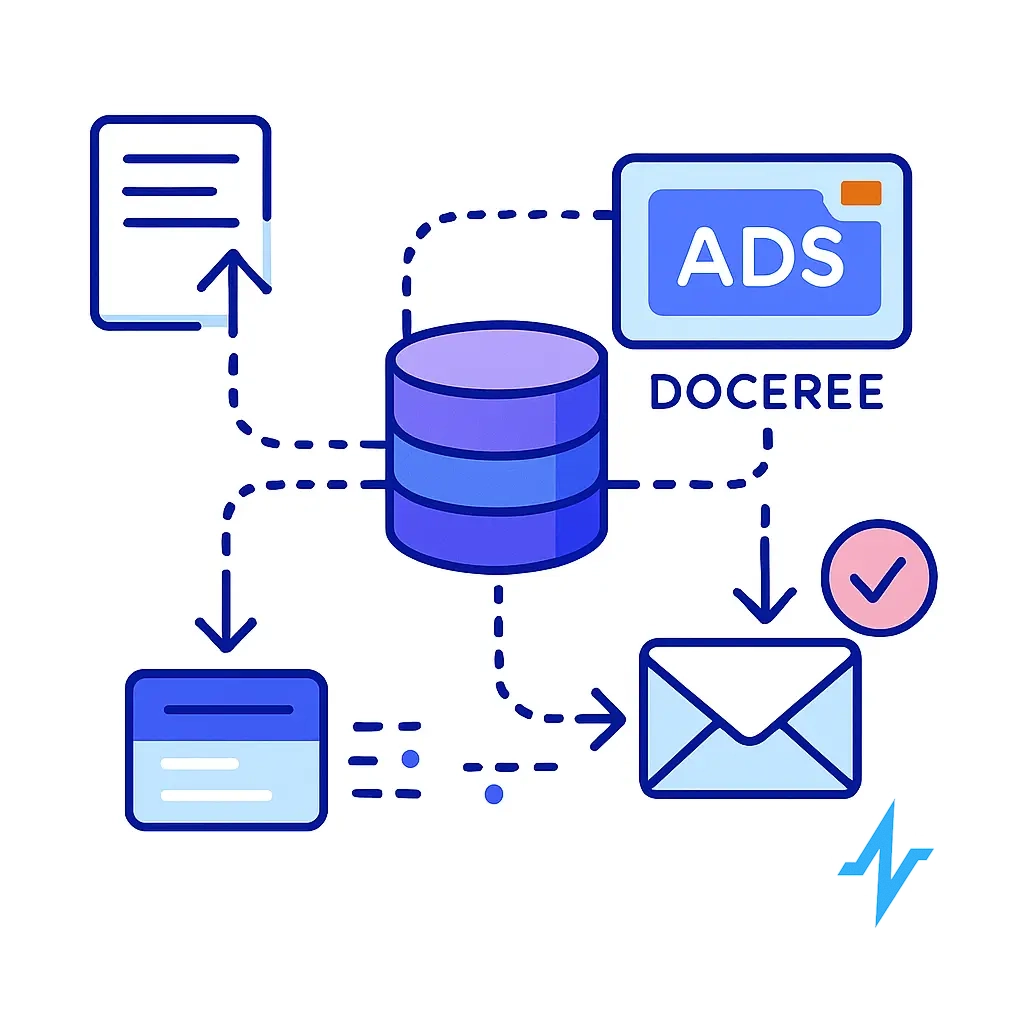
Automatic Data Sync & Triggered Actions: The integration allows data to flow between Doceree and Pulse on a set cadence or in real-time.
Pulse can automatically ingest Doceree campaign data through API connections – such as ad impressions, clicks, or engagement metrics – and update HCP profiles.
This means triggered marketing actions can occur based on Doceree data: for example, if an HCP clicks a Doceree ad for a specific drug, Pulse could automatically enroll them in a follow-up email nurture or flag them for sales rep outreach, according to business rules. Without integration, such responsive, cross-channel tactics would be cumbersome.
Unified Reporting and Analytics: With all interactions under one roof, Pulse provides consolidated analytics to evaluate marketing efforts in one place.
You can measure the impact of Doceree ads in context with other tactics – e.g., comparing engagement rates of HCPs who saw an ad vs. those who only got emails.

Pulse’s dashboard offers real-time 360-degree visibility into brand performance across partners, including Doceree. This helps demonstrate ROI and optimize allocation of budget between channels based on a holistic view of what’s working.
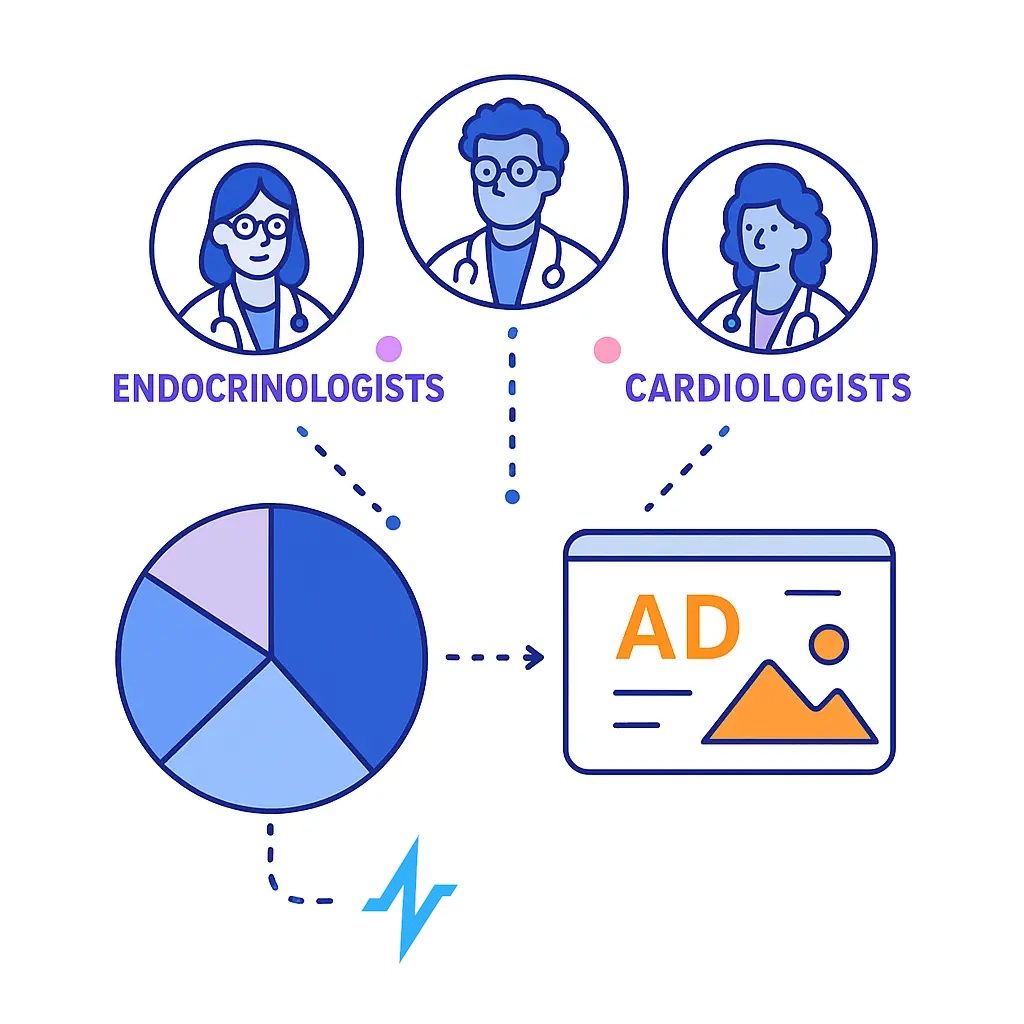
Improved Targeting with Combined Data: Pulse’s rich first-party HCP data and segmentation capabilities enhance Doceree campaigns.
You might use Pulse to define a precise target segment (e.g. endocrinologists who haven’t prescribed your diabetes drug in 6 months) and then seamlessly activate a Doceree campaign to reach that segment with banner ads.
Doceree on its own offers robust targeting (by specialty, geography, behavior, etc.), but integrating with Pulse means you can leverage your proprietary customer insights or CRM data in tandem with Doceree’s network – something not easily done with Doceree alone. In fact, Doceree’s tech is built to easily connect with third-party CRM and data platforms to boost campaign performance, and Pulse provides that connection out-of-the-box.
White-Glove Support & Pharma Compliance: Pulse, being pharma-focused, provides hands-on support to ensure integrations fit into your workflows securely and compliantly.
Rather than a do-it-yourself approach, Pulse’s team can help configure Doceree integration, ensuring things like HCP identifiers (e.g., NPIs or hashed emails) match correctly and that data sharing abides by HIPAA and GDPR rules.

Fortunately, both Pulse and Doceree are designed with healthcare data compliance in mind. This reduces the burden on your IT team and speeds up deployment of the integration.
In short, integrating Pulse + Doceree empowers healthcare marketers to run more efficient, data-driven omnichannel campaigns. You get the benefit of Doceree’s extensive HCP reach and real-time ad engagement, amplified by Pulse’s automation, unified data, and orchestration capabilities – resulting in marketing programs that are greater than the sum of their parts.
How to Set Up the Pulse + Doceree Integration
Setting up the integration between Pulse Engagement Cloud and Doceree is a straightforward process thanks to Pulse’s pre-built connectors. Below is a general step-by-step overview for getting started (exact steps may vary slightly based on updates and your organization’s configurations):
1. Prerequisites – Accounts and Access: Ensure you have an active Pulse Health account (with admin access to integrations) and a Doceree advertiser account.
You may need API credentials or an authentication token from Doceree.
It’s wise to involve your Pulse account manager or support contact early – Pulse’s team offers white-glove service to assist with integrations.
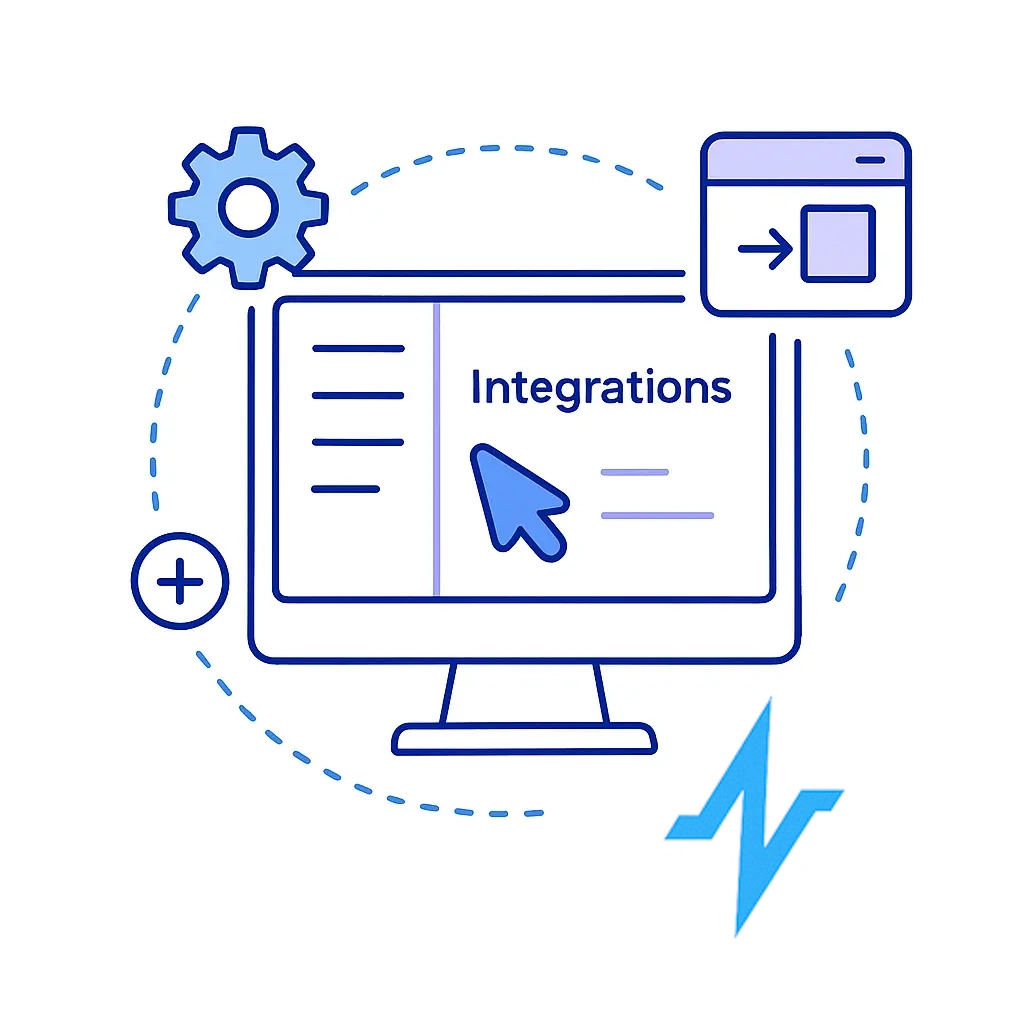
2. Navigate to Integrations in Pulse: Log in to the Pulse Engagement Cloud dashboard. Go to the Integrations section (often found in the admin or settings menu). Pulse provides a library of integrations; look for Doceree in the list of available partners. (If it’s not visible, contact Pulse support – since the integration is pre-built, they might need to enable it for your instance.)
3. Enter Doceree Credentials: In the Doceree integration setup screen, you’ll typically be prompted to enter the credentials obtained from your Doceree account.
This could include an API key, client ID/secret, or OAuth token depending on how Doceree authenticates.
Input these details to allow Pulse to connect to Doceree’s platform securely.
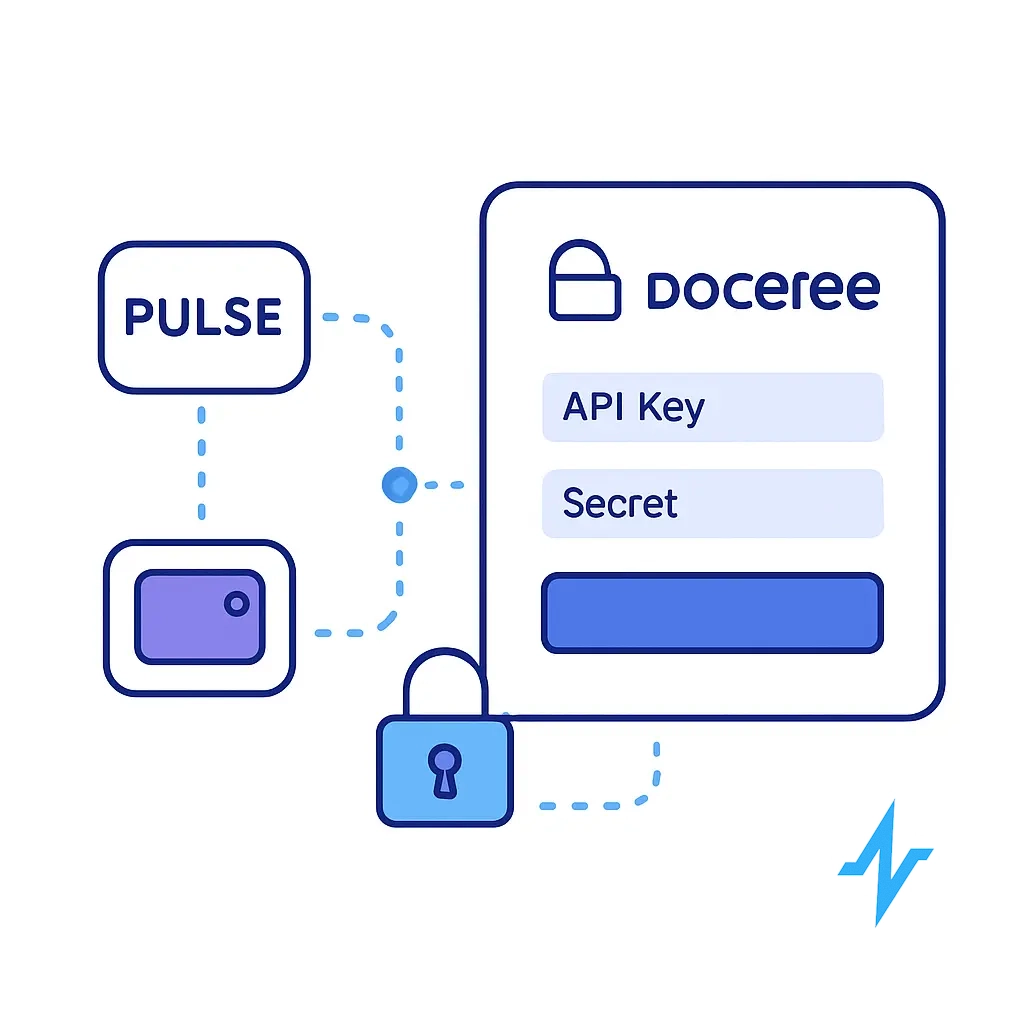
4. Configure Data Sync Preferences: Next, configure what data should flow between Pulse and Doceree.
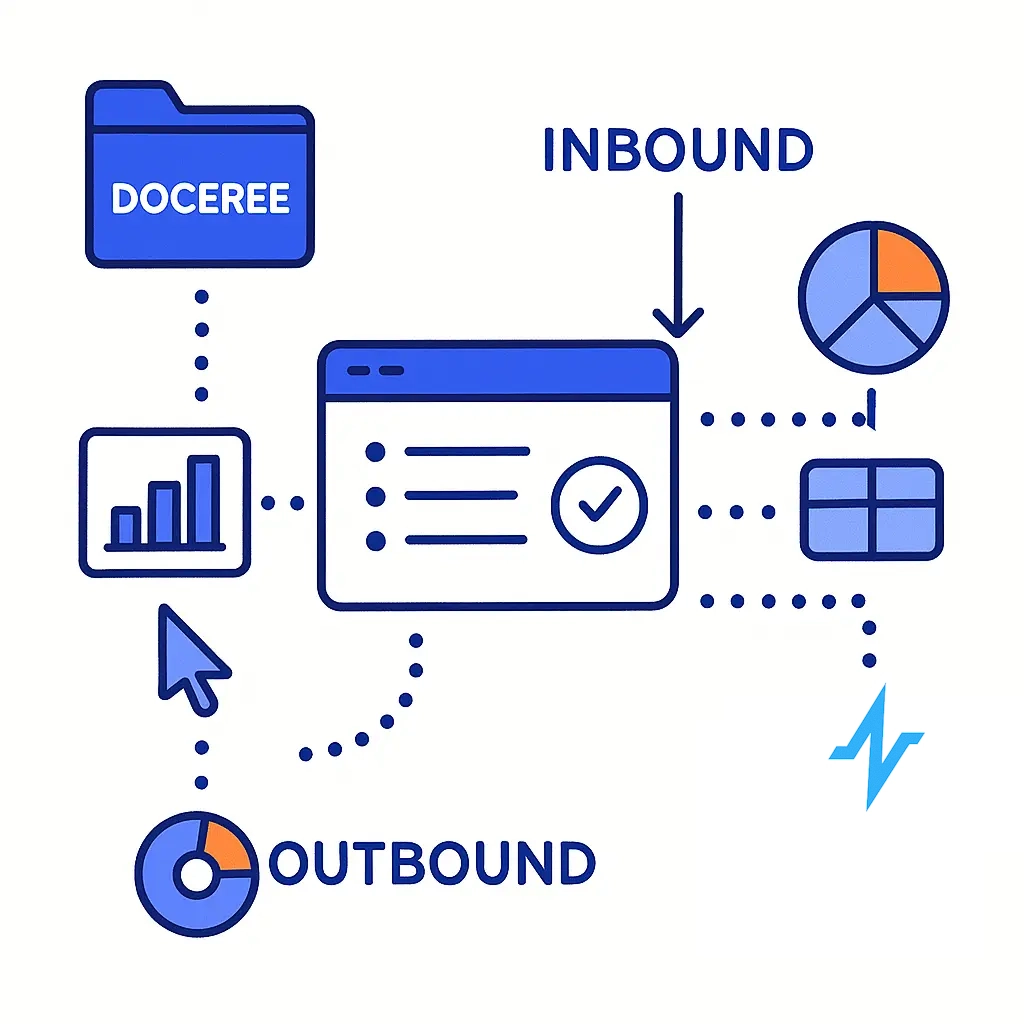
For example:
Inbound (from Doceree to Pulse): Decide which campaign performance metrics to import – impressions, clicks, conversions, etc., and at what frequency. Pulse can ingest Doceree data automatically on a set schedule (e.g., nightly) or even near-real-time via API. This data will populate in Pulse’s database, updating HCP engagement profiles and dashboards.
Outbound (from Pulse to Doceree): If supported, set up any audience or segment sharing. You may map Pulse segments to Doceree targeting criteria. In some cases, Pulse can push an HCP list (e.g., hashed email or NPI list) to Doceree to create a custom audience for a campaign. This ensures your carefully curated Pulse segments are mirrored in Doceree’s platform for targeting. (Note: The exact mechanism may require coordinating with Doceree’s team if list onboarding is involved, but Pulse’s flexible APIs are designed to facilitate such data exchange.)
5. Activate and Test: Once credentials and preferences are set, activate the integration. Pulse will attempt to connect to Doceree’s API. It’s good practice to run a quick test:
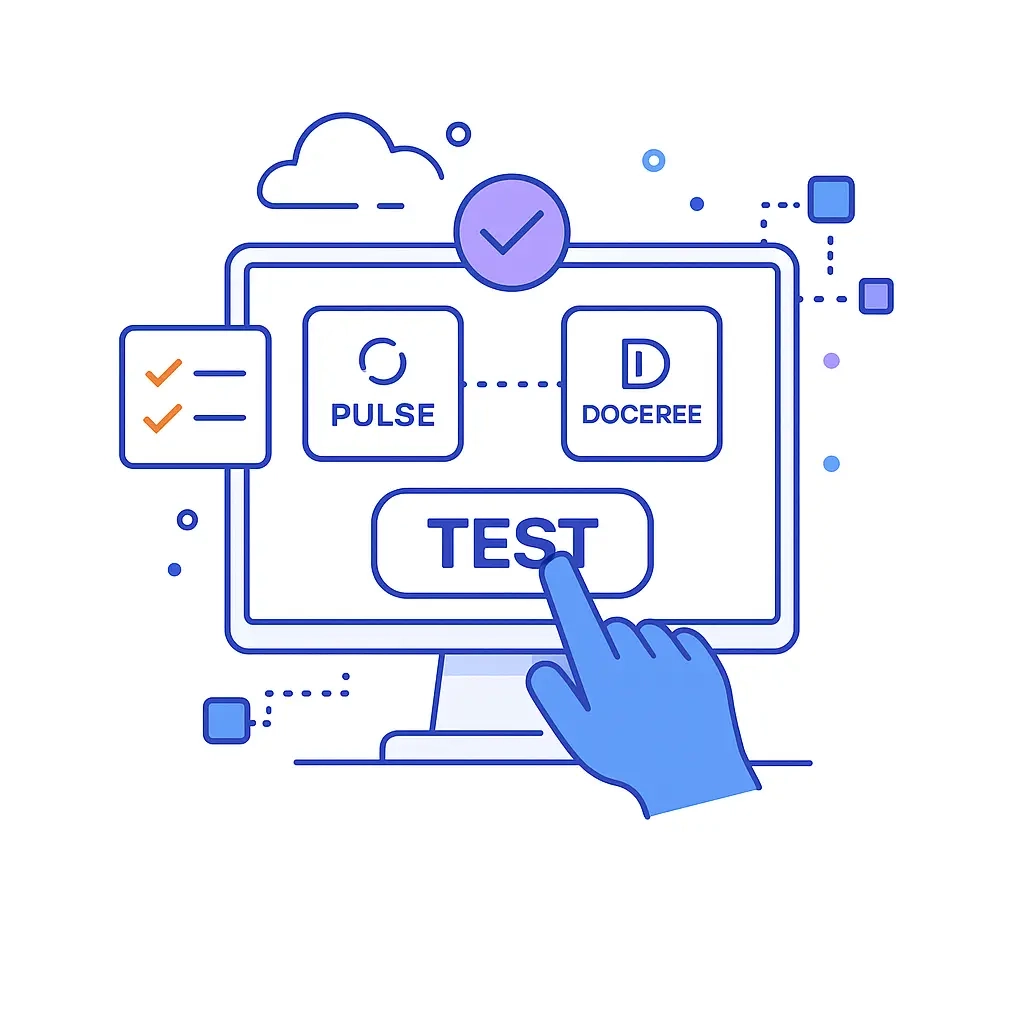
For data import: Perhaps create a test Doceree campaign or use an existing one and see if Pulse pulls in sample data (e.g., last 24 hours of impressions) into a test report.
For audience export: If you configured segment sharing, verify that the segment appears on Doceree’s side or that Doceree received the data. Some integrations have a “test connection” or “sync now” button – use that and check logs for any errors.
Pulse’s support can help verify that data is flowing correctly. Once tested, you can schedule regular syncs (if not real-time).
6. Mapping and Alignment: Ensure that identifiers align between systems. Doceree identifies HCPs by deterministic identifiers (often hashed email or National Provider Identifier).
Pulse’s database likely contains HCP identifiers (Pulse even licenses a database of over 1 million opted-in HCPs).
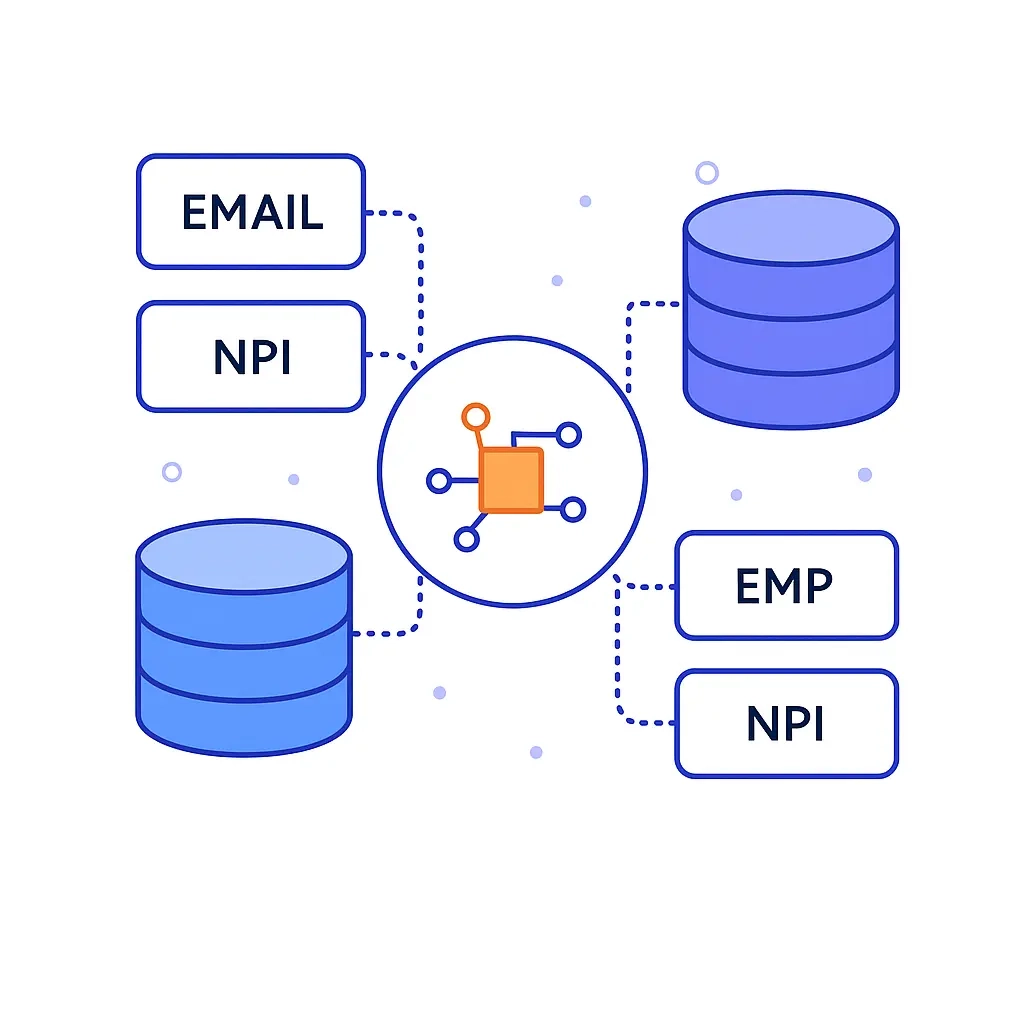
Work with Pulse to map fields like email, NPI, specialty, etc., so that an HCP in Doceree is recognized as the same HCP in Pulse when data comes over. Proper mapping will enable that “full picture” on each profile (e.g., Doceree impression data automatically attaches to the correct doctor in Pulse).
7. Start Using the Integration: With everything connected, begin leveraging it:
Import recent Doceree campaign performance data into Pulse to establish baseline metrics.
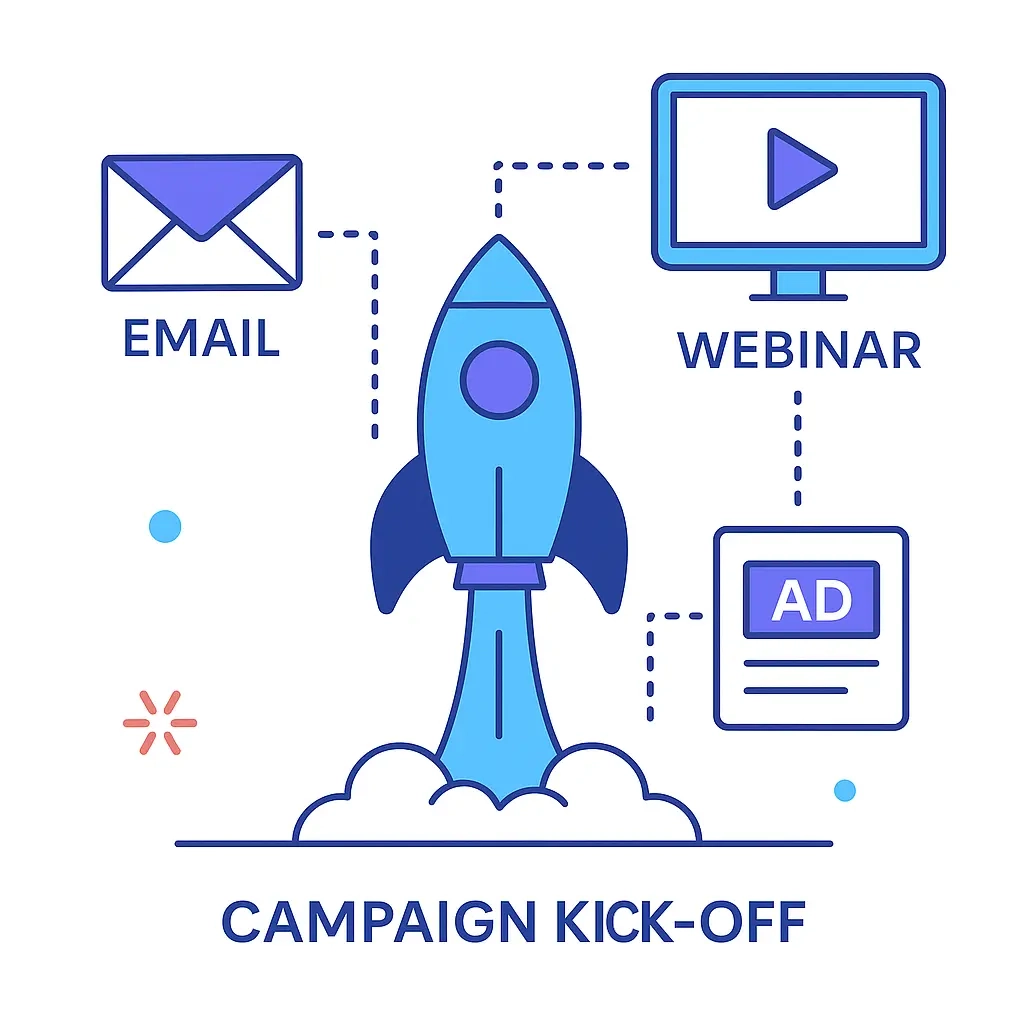
If available, use Pulse’s interface to launch or coordinate new Doceree campaigns. (In some cases, you may still set up the campaign on Doceree’s platform, but you can use Pulse data to inform it and then label the campaign so Pulse can track it.)
Ensure your team knows how to find Doceree-sourced metrics in Pulse reports, and how to use Pulse to push updated audience segments to Doceree when needed.
Pro Tip: Throughout setup, document the configuration and consider creating a standard operating procedure. This way, when you launch new brands or campaigns, you can easily replicate the integration steps. Also, take advantage of Pulse’s support – their life sciences team can “ensure marketing initiatives are seamlessly integrated into your existing workflows”, meaning they’ll help fine-tune the integration for maximum efficiency and effectiveness.
Use Cases and Strategies for Using Pulse + Doceree Together
Once the integration is in place, healthcare marketers can execute sophisticated omnichannel strategies. Here are some key use cases and best practices for leveraging Pulse and Doceree in tandem:
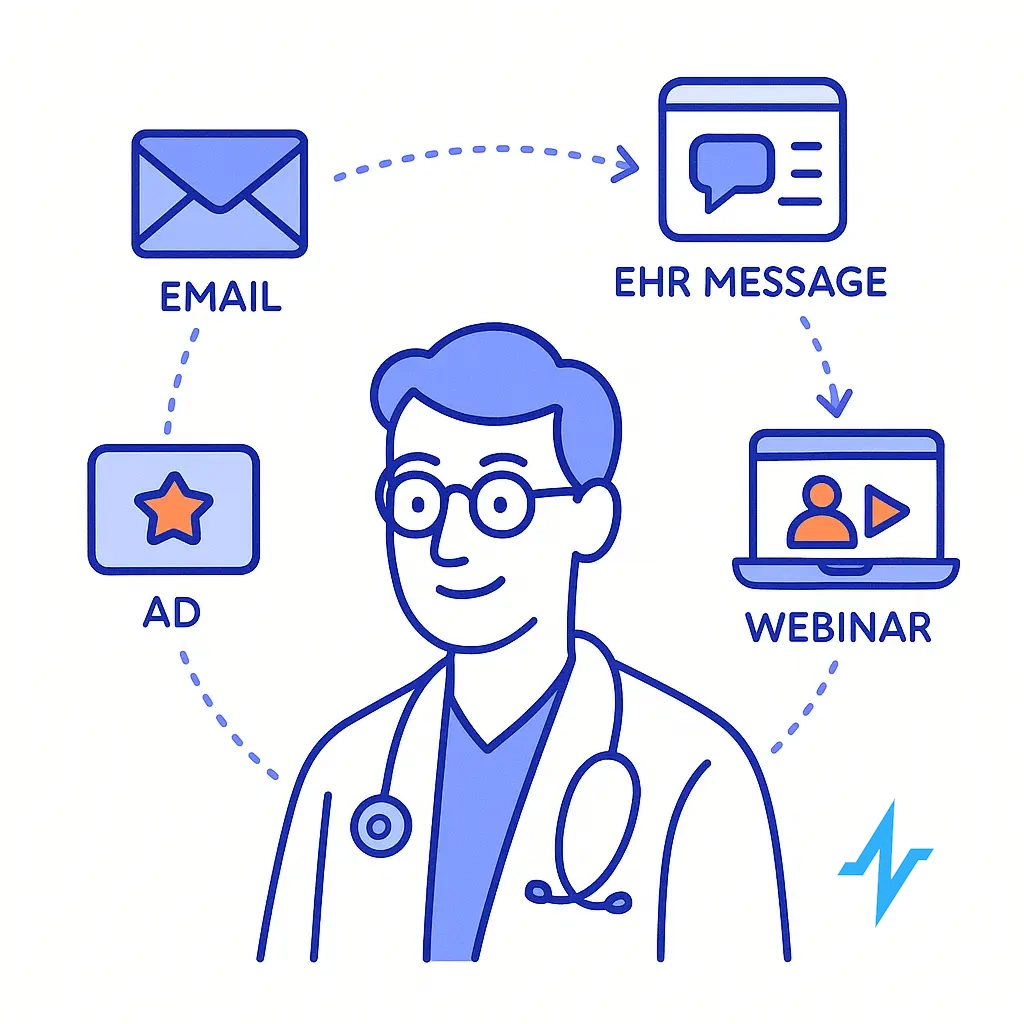
Omnichannel HCP Journeys: Coordinate multi-touch campaigns where Doceree ads and other channels complement each other.
For example, imagine launching a new oncology drug:
Use Pulse to send a personalized email series to oncologists about the new therapy.
Simultaneously, through the Pulse-Doceree integration, serve those oncologists targeted banner ads or in-EHR alerts (Doceree’s point-of-care nudges) reinforcing the email message (e.g., a reminder about the drug’s efficacy) while they’re reading oncology journal sites or writing prescriptions.
Pulse can track which HCPs engaged with the email and which saw/clicked the Doceree ads, giving you a combined response rate. This synergy often yields greater engagement. (In one case, a campaign using an endemic content platform saw 2X higher CTR than industry benchmarks by strategically reaching HCPs via programmatic ads.)
Sequential Messaging and Retargeting: Use Pulse to trigger follow-ups based on Doceree interactions.
Because Pulse can ingest near real-time data from Doceree, you can set up rules like: “If an HCP clicks our Doceree ad (or views a video ad to completion), then 2 days later send them a follow-up email with more details or invite them to a webinar.”
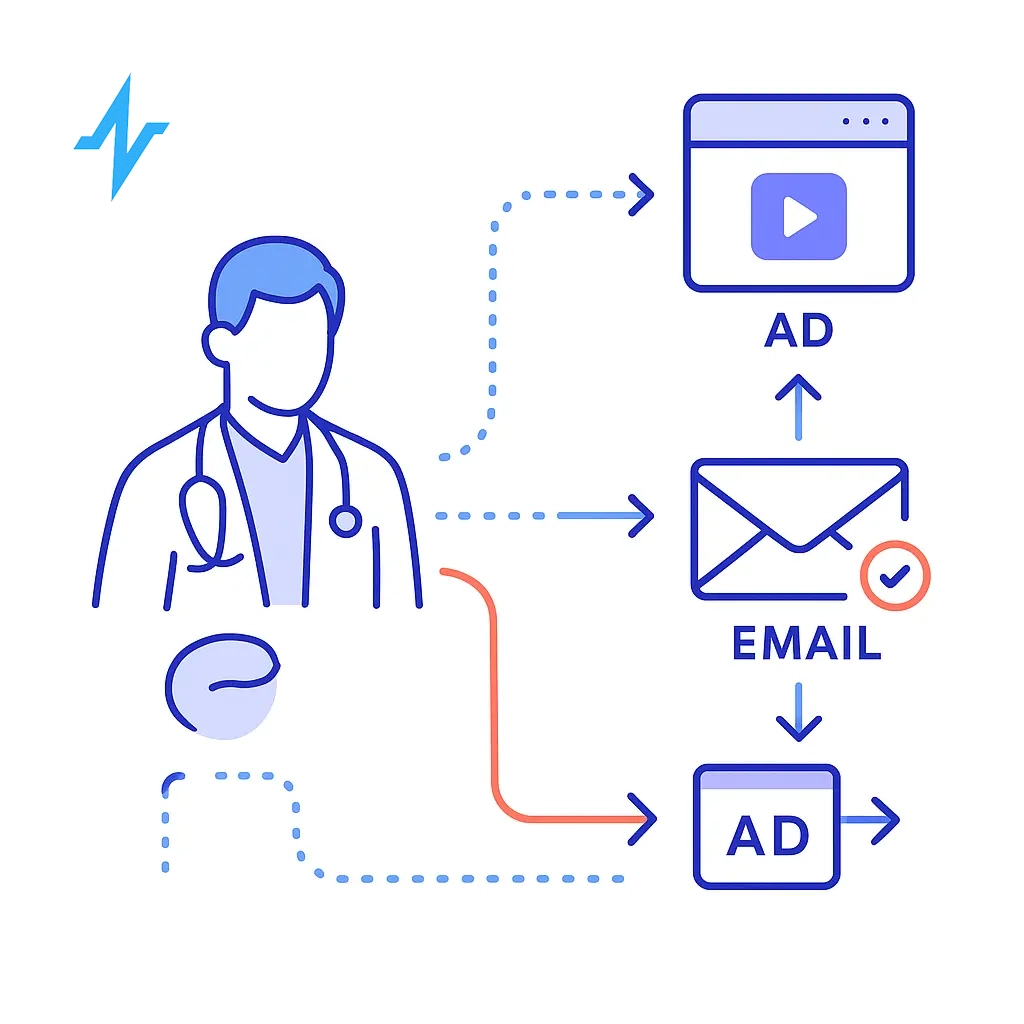
This kind of retargeting is extremely effective since it leverages demonstrated interest. Conversely, you could target HCPs via Doceree who did not engage with an email – Pulse knows who didn’t open or click, and can help you reach them in Doceree’s network as an alternative touch. Such coordinated sequencing ensures no opportunity is missed to engage a potential prescriber.
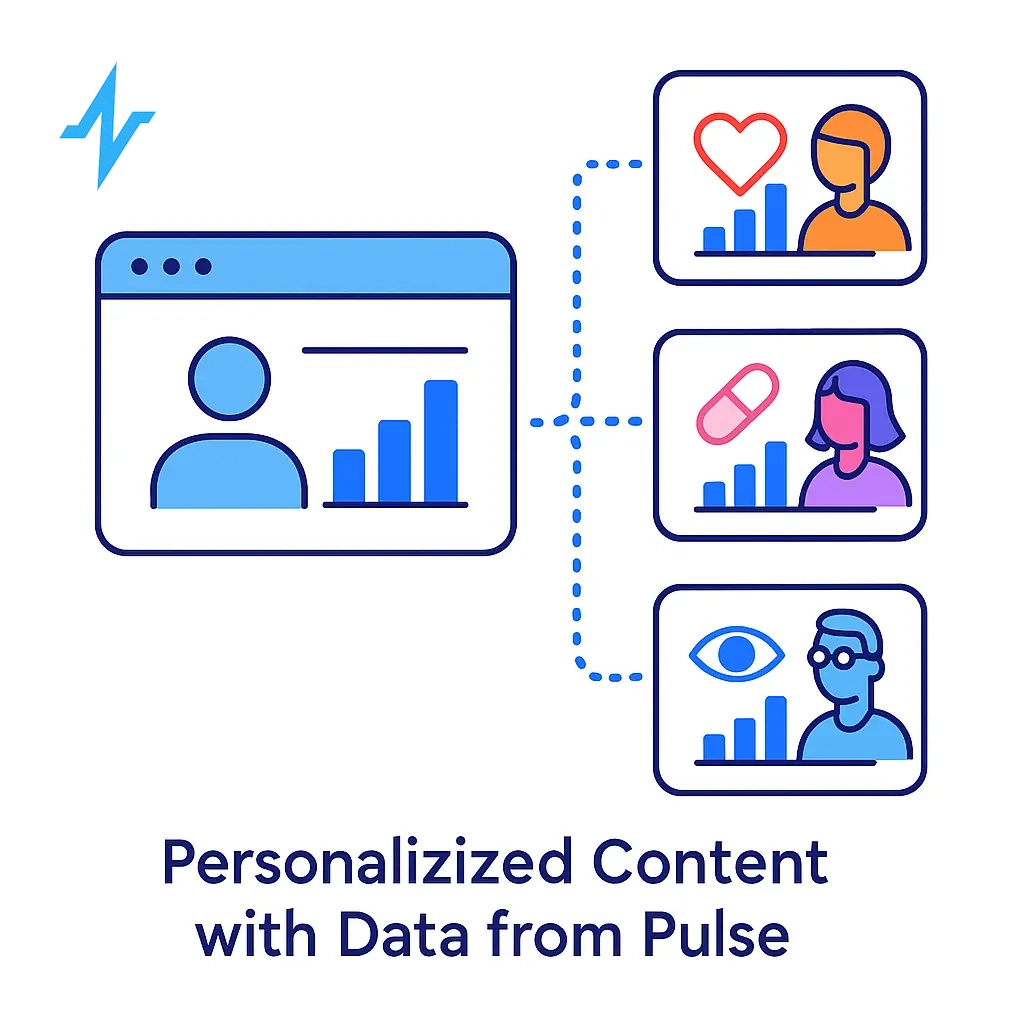
Personalized Content with Data from Pulse: Pulse’s segmentation can drive Doceree personalization.
For instance, Pulse might hold data on each HCP’s specialty, preference, or past engagement.
You can create segments (cardiologists vs. primary care, high decile prescribers vs. low, etc.) and have different Doceree ad creatives or messages for each segment. Pulse can either inform those creative decisions or, if integrated deeply, might automatically select which Doceree campaign an HCP is bucketed into. The result is more relevant ads.
Example: A leading pharma brand in the UK used geo-targeted outreach via Doceree to improve engagement in key regions – with Pulse, you could layer on even more criteria (like targeting only HCPs in certain regions who haven’t attended your events, etc., for an even more refined approach).
Point-of-Care (POC) Engagement: Doceree excels at reaching HCPs in workflow (e.g., within EHRs or e-prescribing systems).
Through Pulse integration, you can tie these POC “nudges” to your CRM strategy.
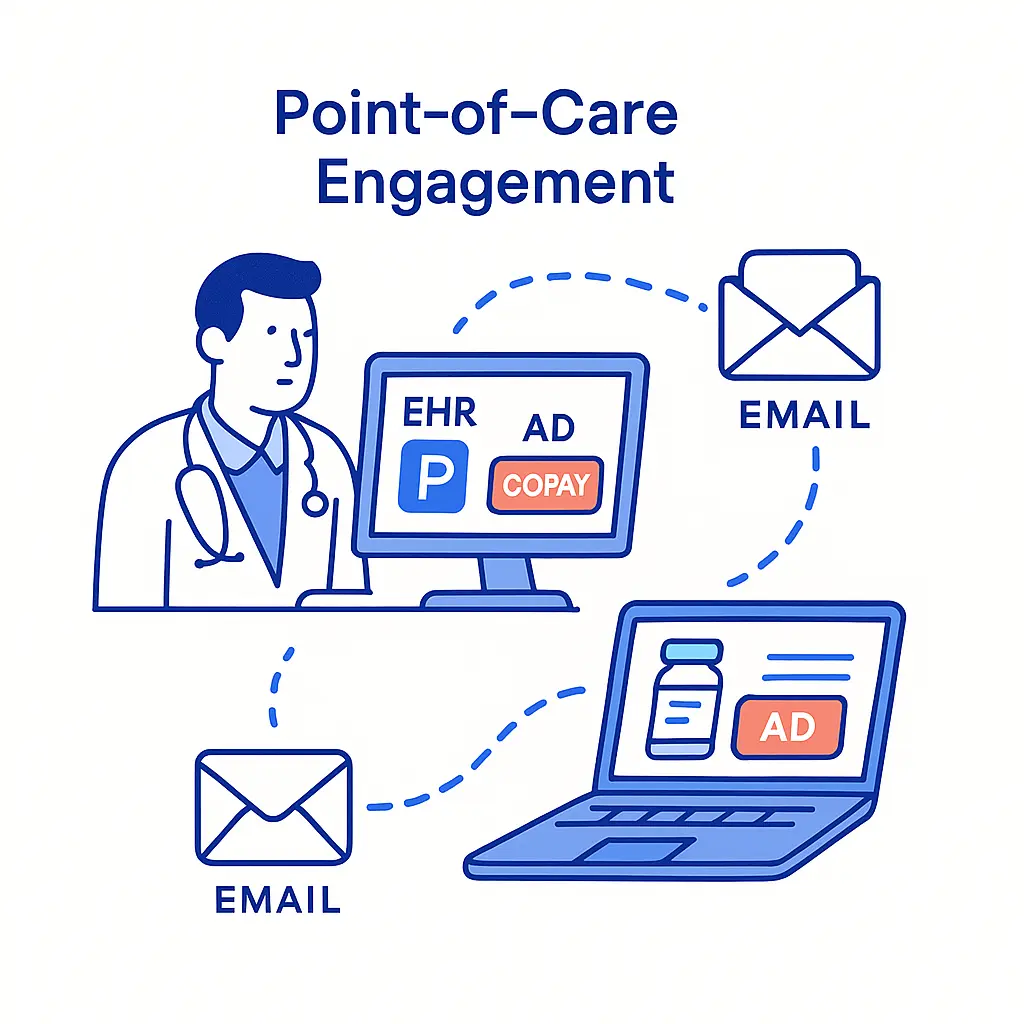
Suppose you use Doceree’s Copay Assist nudges (ads that remind doctors of patient copay programs within the EHR). You can have Pulse monitor which doctors received or interacted with those nudges. If an HCP did, Pulse could trigger a rep notification or an automated follow-up email like “Thanks for helping patients access our drug – here’s more info on the savings program.” This one-two punch can reinforce behavior change.
In fact, Doceree case studies show that embedding copay support in HCP workflows drives significant results – one diabetes brand saw a 46% increase in new prescribers and a 13:1 ROI by raising visibility of its copay program in EHRs. By integrating with Pulse, you ensure those EHR engagements are captured and acted upon (e.g., perhaps also schedule a sample or brochure to be sent via Pulse).
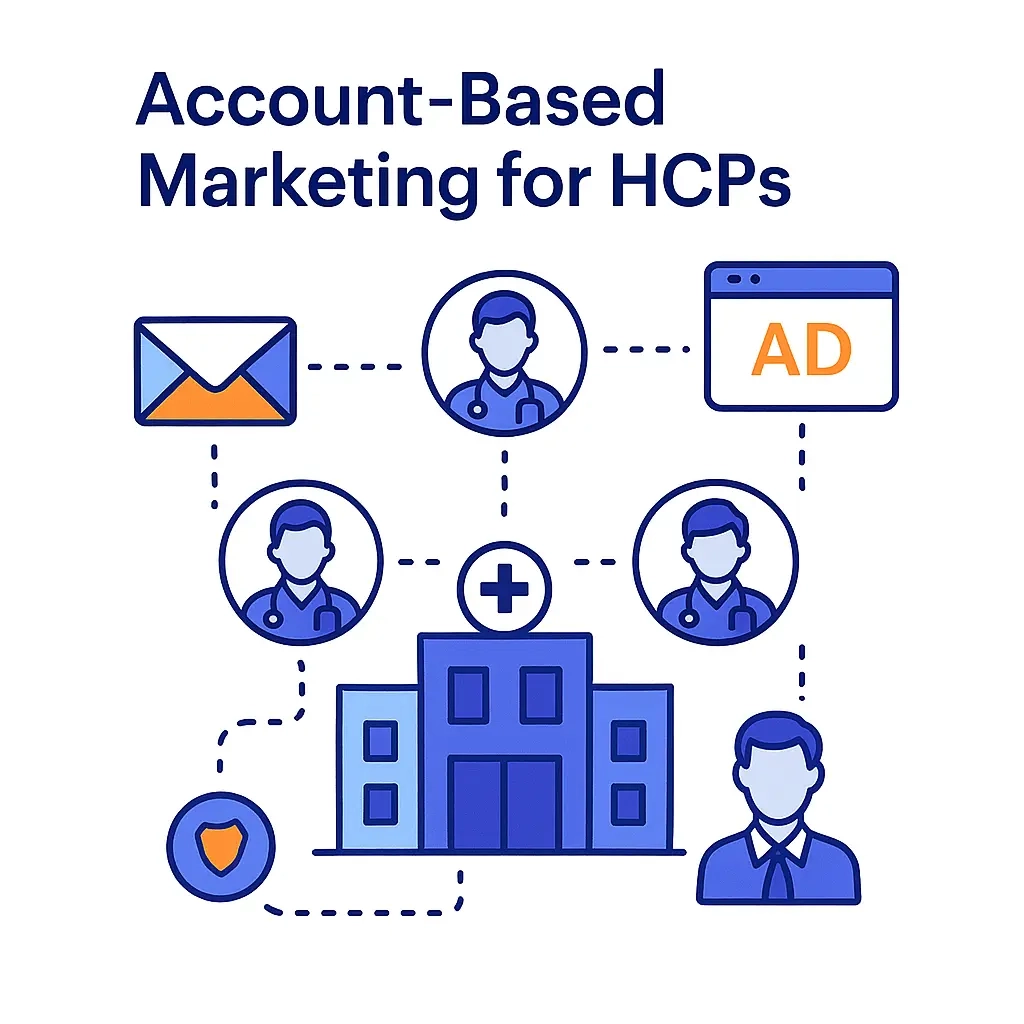
Account-Based Marketing (ABM) for HCPs: For marketers targeting specific institutions or group practices, Pulse + Doceree is a powerful combo.
Pulse can manage your account-level data (e.g., which HCPs belong to Hospital X) and orchestrate tailored outreach.
Doceree, through its ABM Nudges, can amplify reach to decision-makers at those accounts with programmatic ads. Use Pulse to maintain lists of target accounts and deploy coordinated messaging: email to the HCP, ad to the HCP via Doceree, and maybe a direct mail or rep visit – all tracked in Pulse. Doceree’s network coverage across hundreds of medical websites and EHR platforms ensures you can blanket the target accounts digitally, while Pulse logs every touch.
This integrated ABM approach can accelerate awareness and decision-making; for example, Doceree’s own data shows that a strategic digital outreach helped drive 60% intent-to-prescribe increase for a vaccine among targeted HCPs – tying that into an account strategy could push those intent numbers even higher and translate to actual prescriptions.
Real-Time Campaign Optimization: Because Pulse aggregates response data across channels, you can optimize on the fly.
If Pulse reports show that Doceree ads are yielding a high click-through but low site visits (maybe the landing page needs improvement), or that certain segments of HCPs respond better via email than ads, you can adjust your spend or tactic allocation.
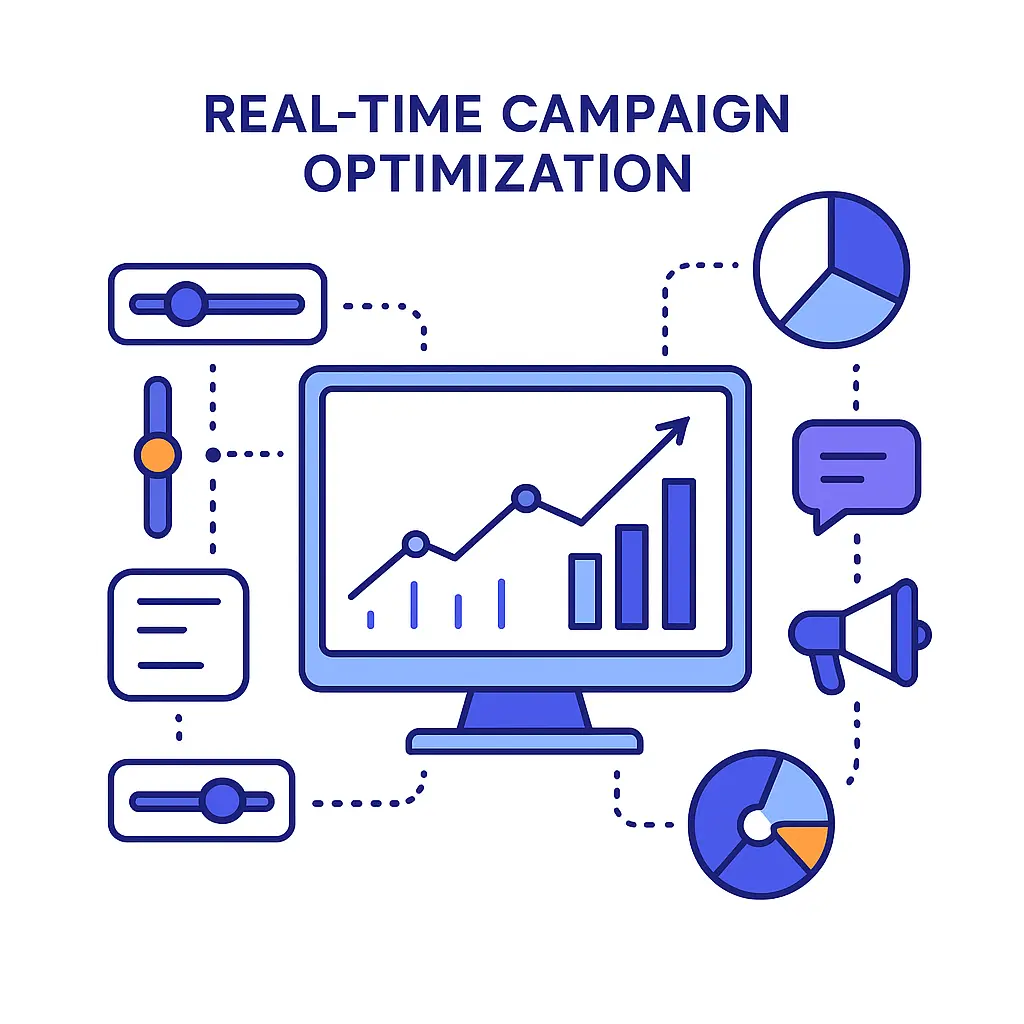
Doceree provides real-time, on-demand insights on campaign performance (including physician-level data and even Rx lift metrics), and with that flowing into Pulse, your team can have quick strategy huddles to tweak content or channel mix. For instance, if you see that your Doceree campaign in an e-prescribing platform is driving many new prescriptions (one Doceree POC campaign boosted new Rx by 19%), you might decide to extend that campaign or invest more in that channel and use Pulse to pull back on less effective channels. Integrated data means faster, more informed decision-making.
Pro Tip: Make use of Pulse’s analytics and visualization to create combined reports. You can create dashboards that show Doceree metrics alongside email, social, and rep-call metrics. Highlight KPIs like reach (HCPs reached via any channel), engagement rate (unique HCPs who clicked an email or ad), and conversion (e.g., requests for samples or actual Rx lift if you have that data). This comprehensive view, enabled by integration, helps justify marketing spend and guide future strategy.
Key Metrics and Performance Insights
When using Pulse and Doceree together, it’s important to track certain metrics to gauge success. Thanks to the integration, many of these metrics can be viewed holistically. Here are key performance indicators and some real-world data points:
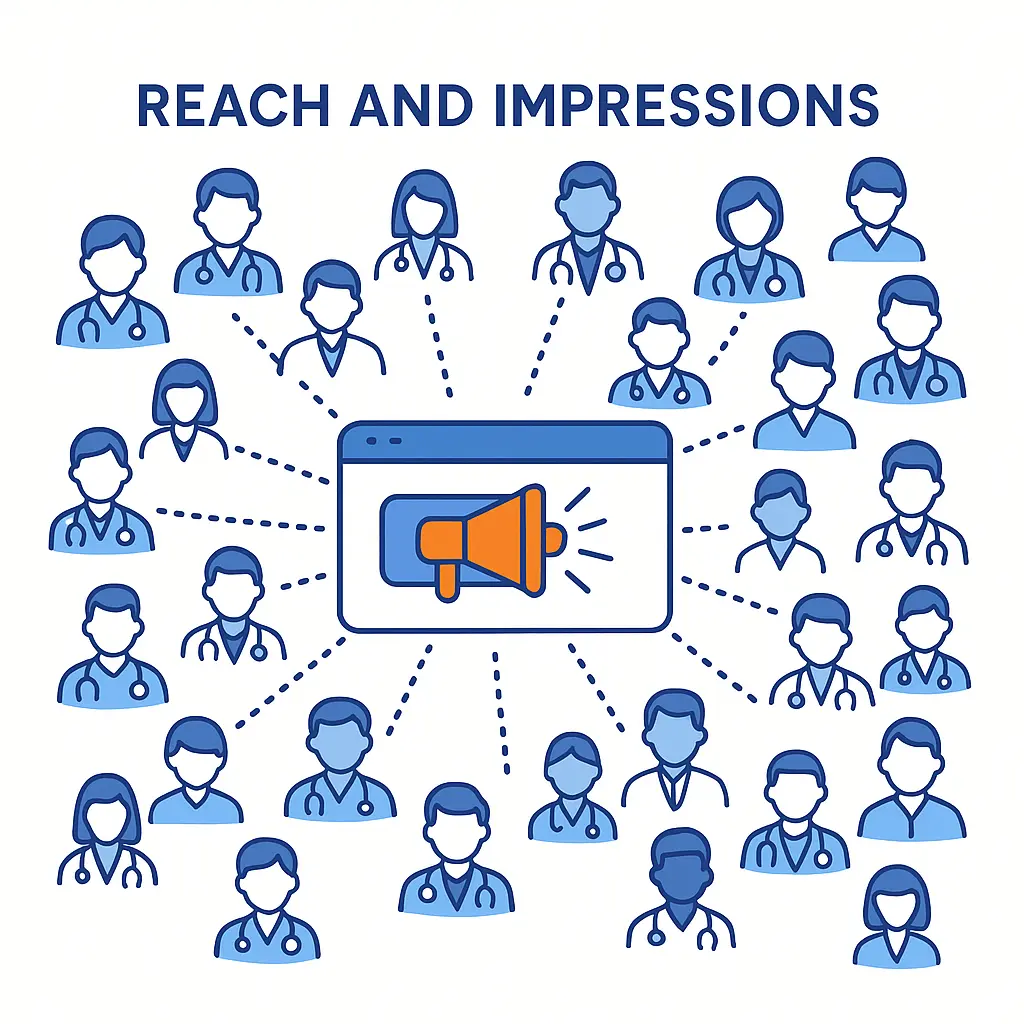
Reach and Impressions: How many unique HCPs are you reaching, and how often?
Doceree will contribute programmatic impressions across its network.
With Pulse’s 360° view, you can ensure these aren’t just raw counts but unique HCP reach (since Pulse can de-duplicate by HCP across channels).
Aim to maximize reach within your target list. For example, one campaign used Doceree’s endemic network to educate over 60,000 HCPs about a disease, which led to a 30% increase in therapy awareness for a new drug.
Engagement Rate (Clicks/Interactions): Measure what percentage of those reached actually engaged (clicked an ad, opened an email, etc.).
Doceree’s platform has achieved engagement rates far above industry norms – one case saw 2X the benchmark CTR by using Doceree’s programmatic outreach to a specialized audience.
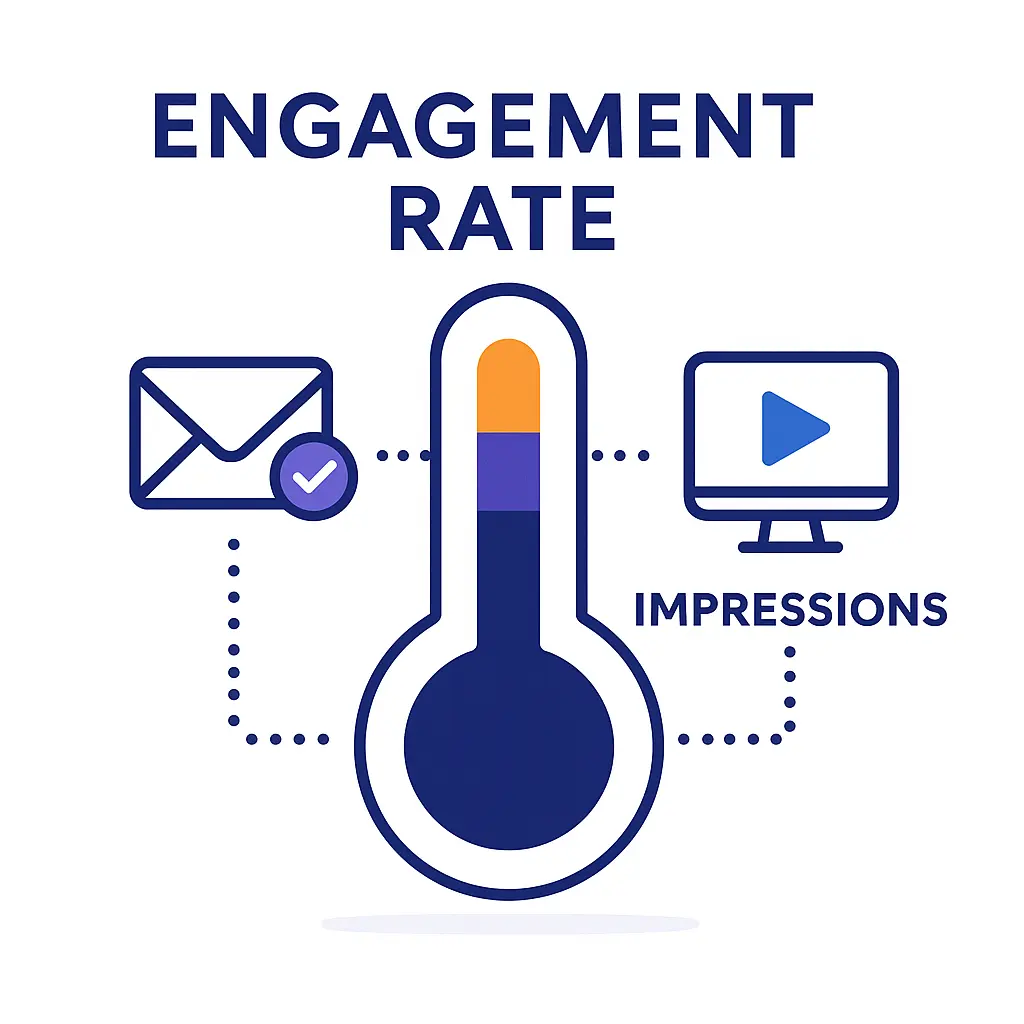
Through Pulse, compare engagement by channel: are Doceree clicks complementing email opens? Use this to optimize content and targeting.
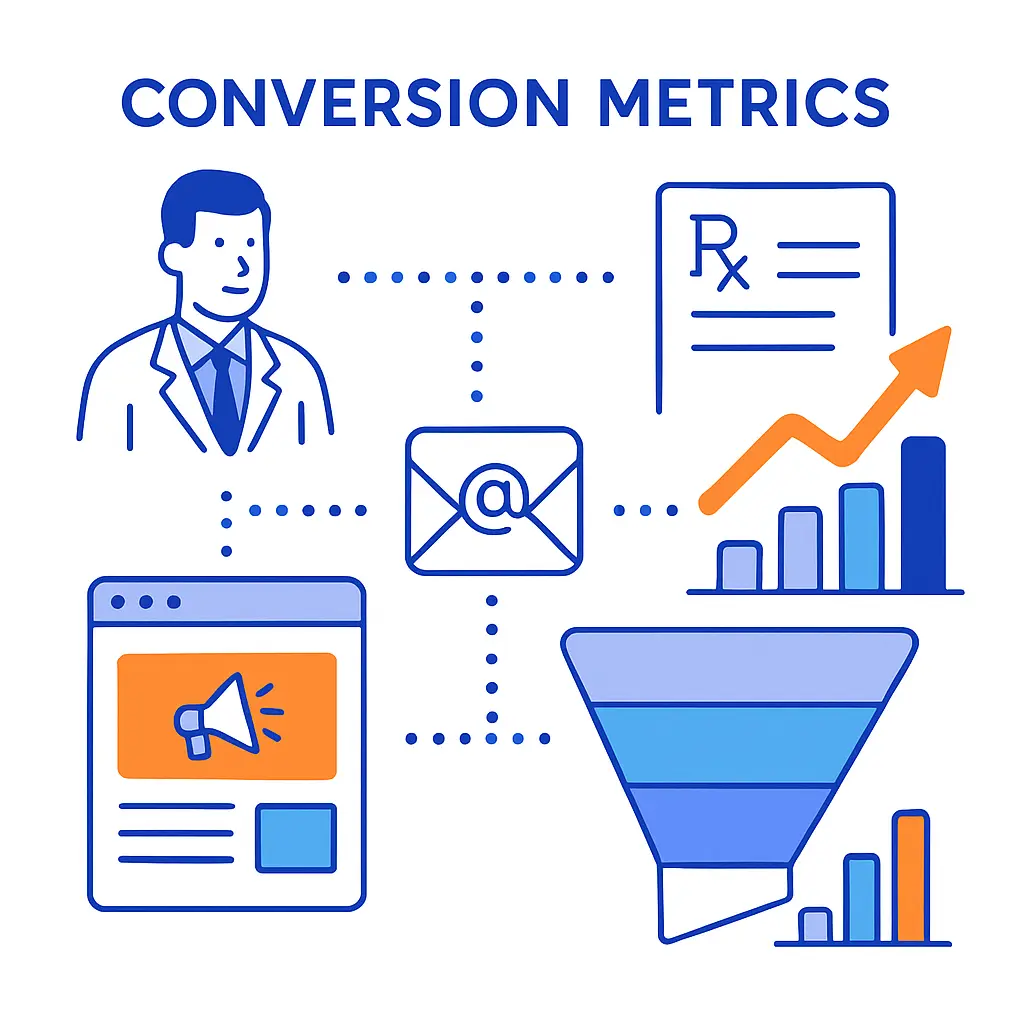
Conversion Metrics: Depending on your goals, this could be HCPs registering for an event/webinar, downloading content, writing a prescription, etc.
Pulse can track conversions like event sign-ups or content downloads directly, and it can also ingest downstream metrics like new prescriptions if provided by data partners or Doceree studies.
Doceree often conducts custom studies to connect ad exposure to script lift.
If available, look at metrics such as:
- New Prescriber Count: How many new HCPs started prescribing after engagement. (Integration helps attribute this – e.g., X new doctors wrote a script after seeing our Doceree ads and receiving Pulse emails). In the earlier example, integrating copay messaging led to a 46% increase in new prescribers for that diabetes brand.
- Prescription Lift: The relative increase in prescriptions or intent to prescribe. For instance, Doceree reported a 19% boost in new prescriptions from a trigger-based messaging campaign, and Pulse’s platform overall has been credited with up to 20% script lift for brands using its omnichannel approach. By combining efforts, you can hope to see similar or greater lifts. Track formulary pull-through or sales data (if accessible via Pulse integration with CRM) to see tangible outcomes.
- ROI: Return on investment is king. Use Pulse’s analytics to calculate ROI for your integrated campaign. Doceree’s case studies often highlight impressive ROI (e.g., 13:1 ROI in the copay/EHR campaign). When you factor in all channels via Pulse, you can attribute cost and revenue to get a full ROI picture. Perhaps your integrated approach yields better ROI than running email or ads alone, thanks to the synergy – this is a key proof point for stakeholders.
Engagement by Segment: Because Pulse lets you slice data by segment, you can see if certain HCP segments respond better via Doceree vs. other channels.
Maybe specialists respond to programmatic ads more than primary care physicians do, or vice versa.
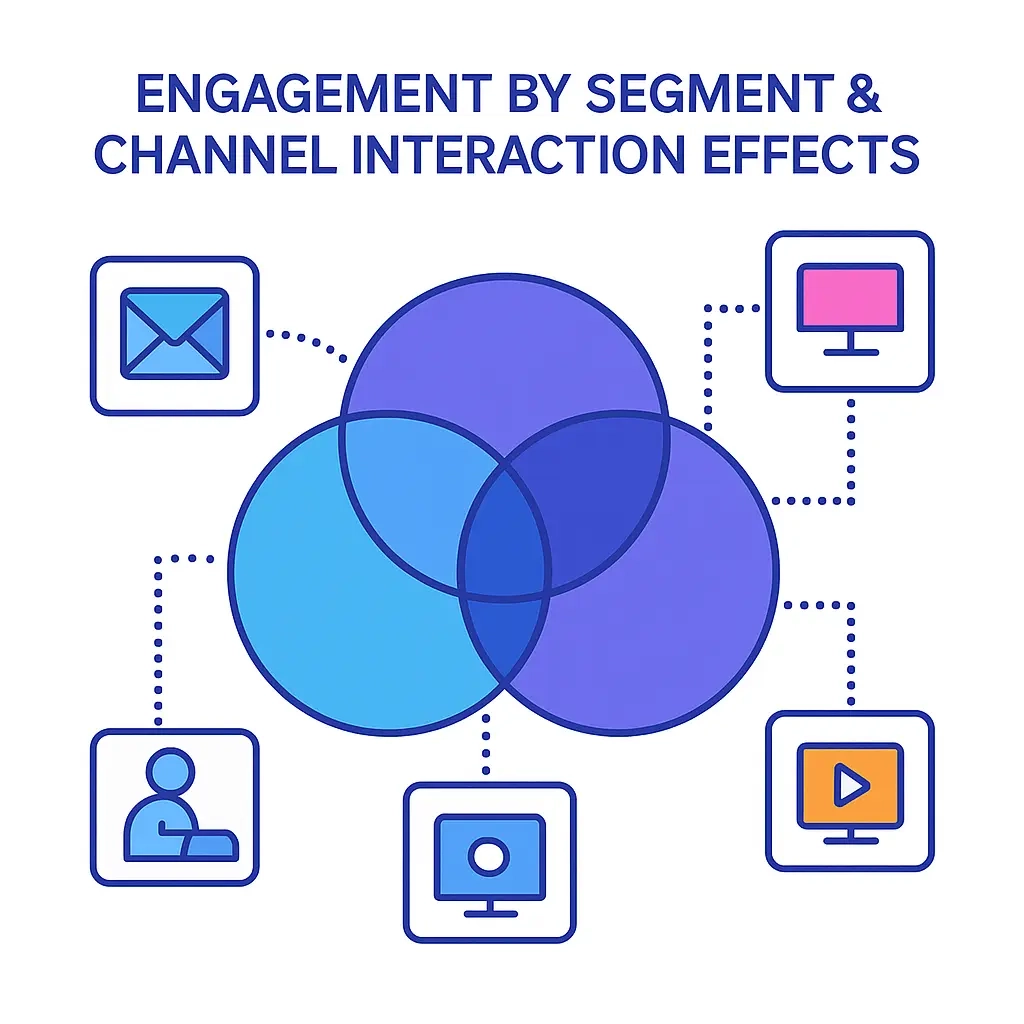
Monitor metrics like CTR or content interaction by segment in Pulse’s reports. This can inform future segmentation and personalized content strategy.
Channel Interaction Effects: A more advanced insight is to look at how channels influence each other. For example, did HCPs who were exposed to both Doceree ads and Pulse emails have higher engagement or conversion than those exposed to only one? Pulse’s unified data makes such analysis possible. If you find a strong positive interaction (which is often the case in omnichannel marketing), use that evidence to justify maintaining an integrated approach. It validates that Doceree + Pulse together drive incremental value.
When reviewing metrics, leverage Pulse’s real-time dashboards and reporting flexibility. Doceree provides physician-level detail and on-demand analytics – by feeding that into Pulse, you can create custom reports (even integrating with your own KPIs or third-party data). Always tie the metrics back to business outcomes: e.g., “Our integrated campaign not only delivered a high click-through on educational content but also correlates with a 15% increase in therapy initiation in the target group, demonstrating a clear impact on prescriptions.” With concrete numbers from sources like Doceree’s case studies and Pulse’s analytics, you can confidently report outcomes and iterate on strategy.
How Pulse Enhances Doceree: Achieving What Doceree Alone Can’t
Doceree by itself is a powerful tool for digital HCP engagement – it offers broad reach, precise targeting, and great analytics within the programmatic advertising realm. However, Pulse Health’s integration takes those capabilities further by embedding them into a larger marketing orchestration system. Here are the key advantages Pulse brings that a Doceree-only approach would lack:
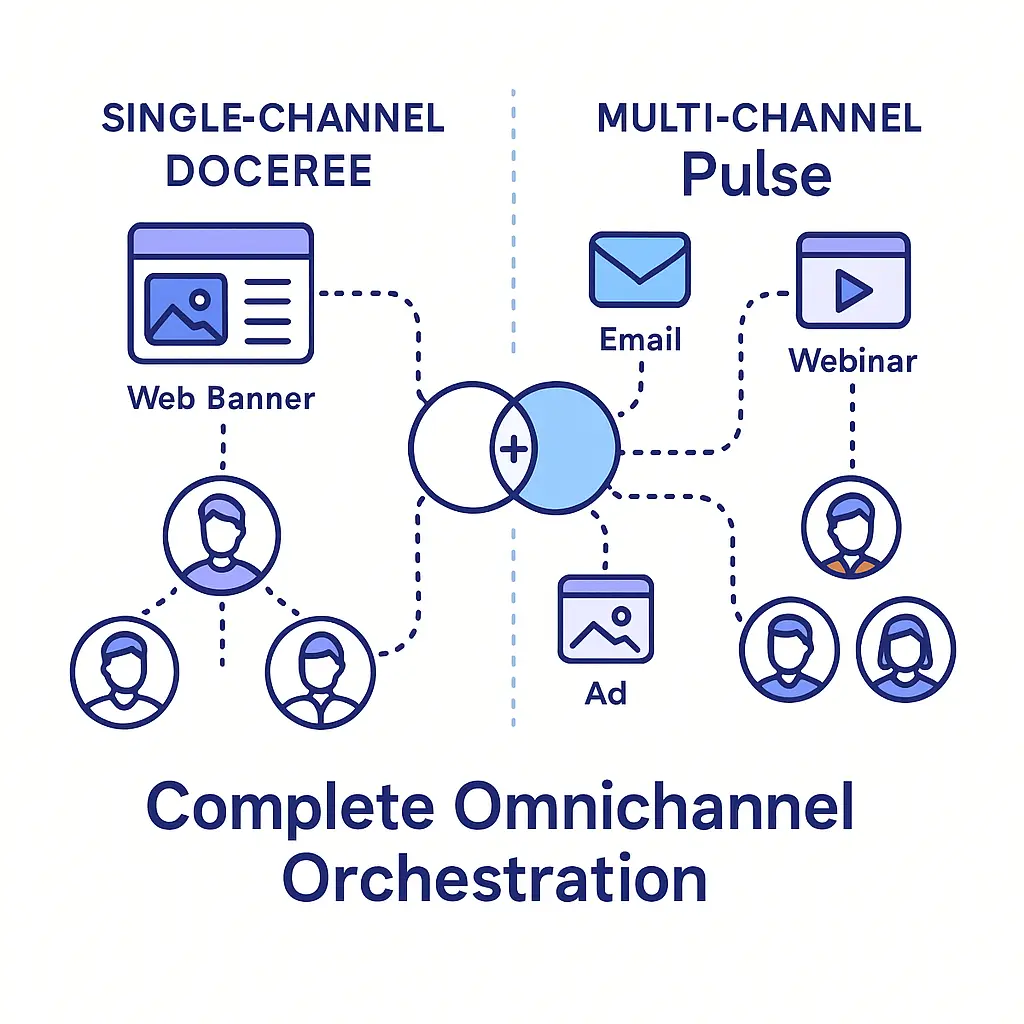
Complete Omnichannel Orchestration: Doceree focuses on programmatic ads (display, video, EHR-integrated messages).
With Pulse, you can orchestrate all channels around those ads – email, sales reps, events, direct mail, etc.
This means an HCP gets a coordinated experience rather than disjointed touches. Doceree can’t send emails or trigger a rep call – but Pulse can, using Doceree data as a cue. This synergy ensures HCPs progress through a well-designed journey, improving overall engagement and message reinforcement.
Centralized HCP Profiles and CRM Integration: Pulse acts as a mini-CRM for marketing, consolidating all data on each HCP.
Doceree will tell you about ad impressions and clicks, but it won’t inherently know that, say, Dr. Lee is a high-value target who also met a rep last week or that she attended a speaker program.

Pulse holds those insights. By integrating Doceree, all those Doceree touchpoints get added to Dr. Lee’s profile. The result: a single, rich profile per HCP that marketing and sales can reference. You can then tailor interactions with that knowledge. Doceree alone would have a siloed view (only digital ad engagement), but Pulse gives the full context of each HCP’s engagement across channels.
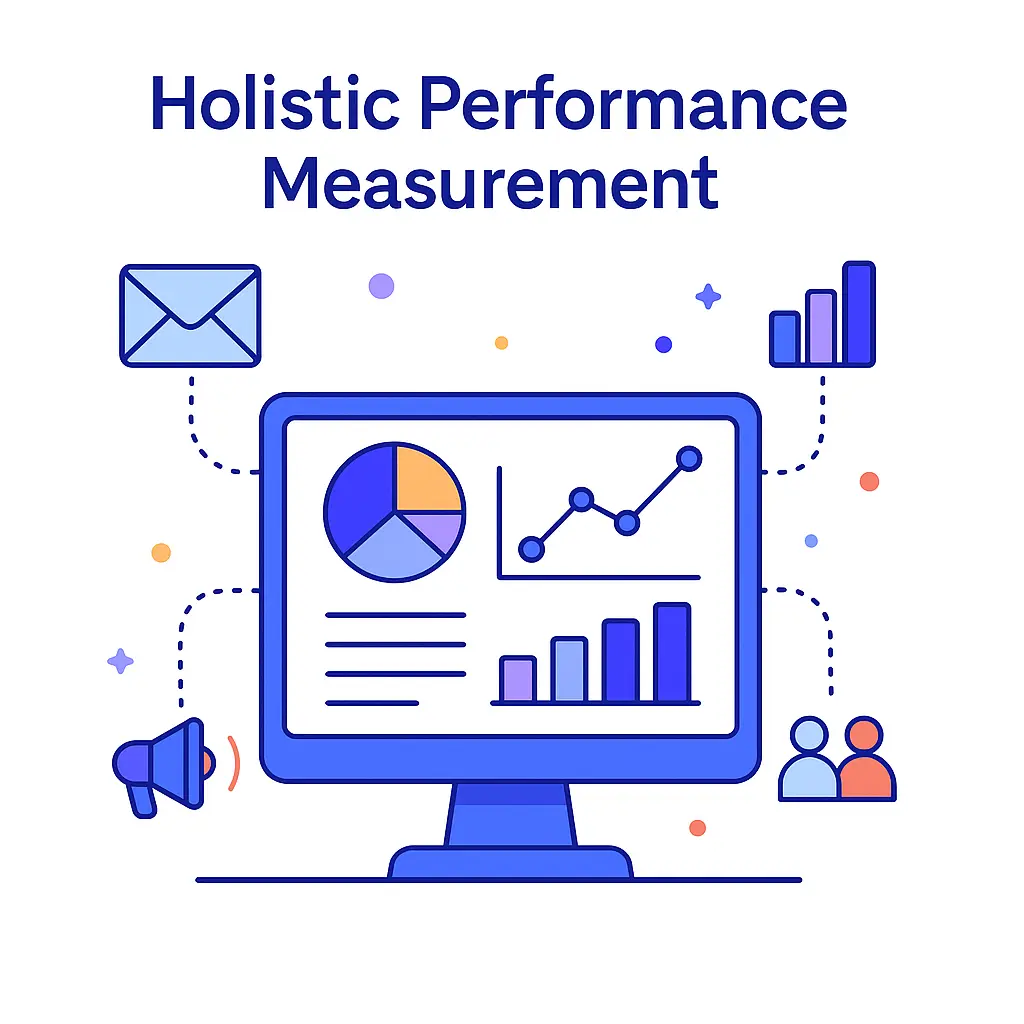
Holistic Performance Measurement: Pulse’s 360-degree dashboards mean you can attribute and compare the impact of Doceree within the broader marketing mix.
For example, perhaps Doceree drove 100 webinar sign-ups while emails drove 50 – but many HCPs were touched by both.
Pulse can deconflict and attribute influence properly (multi-touch attribution). Doceree’s own reporting is strong for its channel, but it won’t automatically merge with email or sales data. Pulse provides that combined measurement, allowing you to see Doceree’s true contribution to outcomes like script lift or HCP activation in context.
Data-Driven Optimization and AI: Pulse, as a marketing automation platform, can include AI-driven recommendations, lead scoring, or predictive analytics using the integrated data.
For instance, Pulse might score HCPs based on engagement (including Doceree engagements) to prioritize who sales should visit or who should enter an intensive nurture program.

Doceree doesn’t offer that kind of cross-channel lead scoring – Pulse does, using all input. Additionally, Pulse can automate multivariate testing across channels (e.g., test one message in email vs. ads). By having Doceree as part of the mix, these optimizations consider a wider funnel.
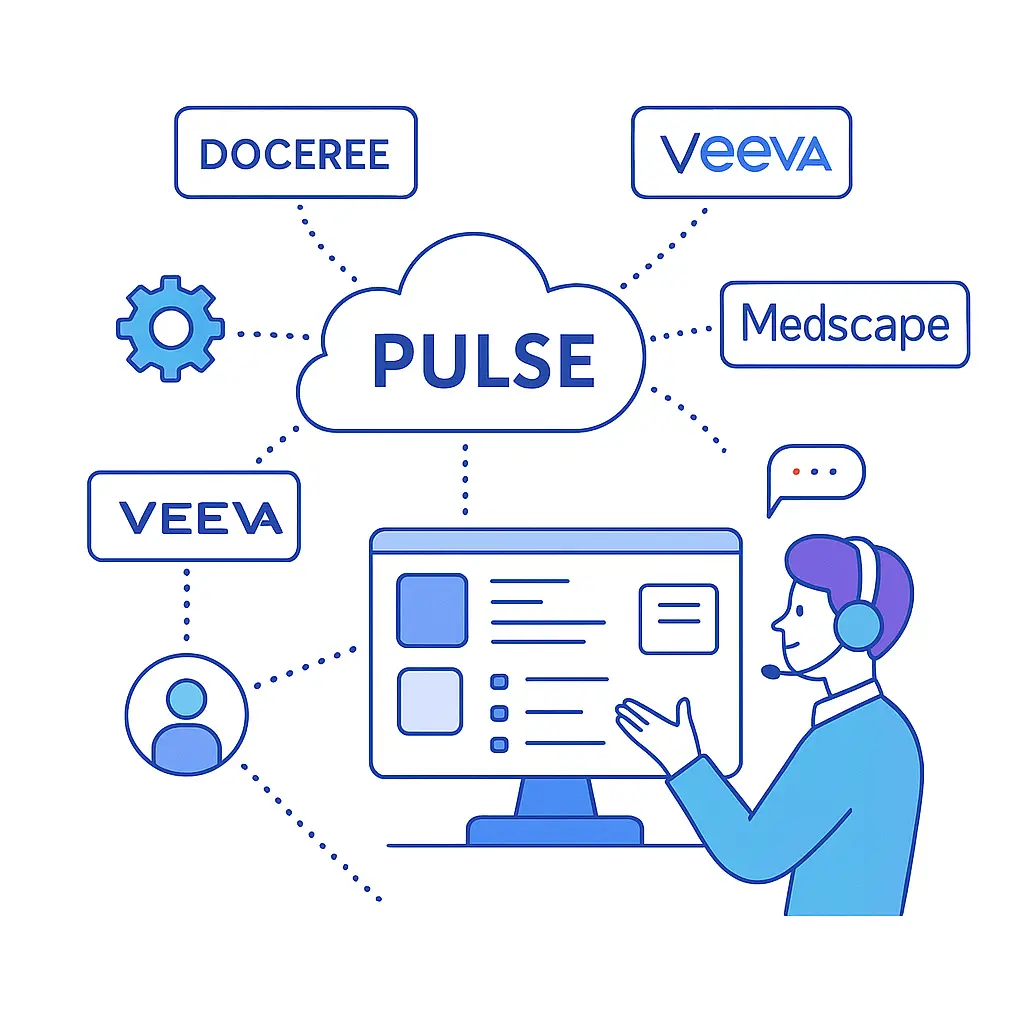
Expanded Integrations Ecosystem: If you’re using Doceree alone and want to connect it to other tools (say your Veeva CRM, or Google Analytics for your website, etc.), you would have to integrate each separately.
Pulse simplifies this because it already has plug-and-play integrations with many platforms (Veeva, Doximity, Sermo, Medscape, Google Analytics, and more).
So Doceree data in Pulse can be correlated with data from those other sources too. For example, Pulse could integrate with Veeva CRM to pull in prescription data and then match it with Doceree exposure data to prove outcomes. Doceree alone might tell you an HCP saw an ad, but Pulse can tell you that same HCP increased prescribing, because Pulse can pull in script data via another integration. This combined insight is a game-changer for proving marketing value and learning which tactics truly drive prescriptions.
Operational Efficiency and Support: Using Pulse + Doceree means your team has one primary interface (Pulse) to learn and operate for campaign management and analytics, rather than juggling multiple platforms.
Pulse’s interface is built for pharma marketers and might feel more intuitive for orchestrating complex campaigns than a generic ad platform.

Moreover, Pulse’s support will help manage the Doceree connection. In contrast, if using Doceree alone, your team might spend more effort manually exporting reports, uploading lists, etc. Pulse automates those tedious tasks (data uploads, report pulls) so your marketers can focus on strategy and creative rather than platform management.
To illustrate the difference: Doceree can tell you that Dr. Jones saw your ad and clicked it. Pulse + Doceree together can tell you that Dr. Jones (a cardiologist in your target list) clicked the ad, then visited your booth at a conference (tracked via Pulse), and eventually increased her prescribing of your drug by 20% (pulled from sales data). And Pulse would have automatically sent Dr. Jones a follow-up email after the ad click, which she also engaged with. This comprehensive, orchestrated outcome is simply not achievable with Doceree in isolation.

Pulse essentially amplifies what Doceree can do – by integrating it into a broader engagement strategy, providing richer data context, and enabling actions on that data. As Ryan Alovis (CEO of Pulse Health) noted, the platform is built “delivering both advanced technology and hands-on support” and “facilitates effortless omnichannel deployment and comprehensive performance measurement” via its integrations. For Doceree users, this means the difference between running a programmatic ad campaign versus running a fully-fledged omnichannel campaign with programmatic ads as a key component. The latter drives deeper insights and, ultimately, more impactful results for brand success.

Leveraging an integrated tech stack is essential for maximizing HCP engagement.
The Pulse + Doceree integration exemplifies how two specialized platforms can work in harmony to deliver better outcomes for healthcare marketers.
Doceree brings incredible capability in reaching and influencing HCPs via digital channels, while Pulse provides the orchestration, data unification, and automation to use that capability to its fullest extent.
By following the setup steps and best practices outlined above, marketers can create seamless experiences for HCPs – delivering the right message at the right time and place, whether that’s an email in the inbox or a helpful ad within an e-prescribing workflow. The benefits range from operational efficiency (one-stop campaign management) to strategic advantages like unified analytics and higher ROI. Notably, real-world campaigns have demonstrated the power of this approach: from 13:1 ROI gains to double engagement rates and significant lifts in prescribing intent and volume.
Ultimately, Pulse Health’s integration with Doceree enables what every healthcare marketer strives for: true omnichannel engagement that is data-driven and measurable.

By tapping into Pulse’s “single source of truth” for HCP data and Doceree’s expansive network, you’ll be able to craft and assess campaigns that not only reach healthcare professionals, but also resonate with them and drive meaningful behavior change. It’s a combination that helps turn marketing interactions into improved patient outcomes – and that is the heartbeat of successful healthcare marketing in the digital age.
If you want to learn more about using the power of Pulse Health and Doceree together, along with countless other integrations, book a free demo today.
